
Treasures of the Aegean
May 2-11, 2024
Mike and Judy Henderson
Judy wanted to see Athens and other parts of Greece. We looked a several cruise opportunities, but most focused on Turkey or went from Athens up the Adriatic to Venice. This Tauck cruise, although fairly short (10 days), focuses much more on Greek cities and islands.

++++++++++++++++++++++++++++++++++++++++++
April 29, 2024 (Monday) The tour starts on May 2nd, and we get an extra day before the tour from Tauck, but we couldn't get decent flights on April 30th. So we decided to go a day earlier and pay for one night at the hotel ourselves. We arrive in Athens about 6:30 pm on April 30th so we'll have a free day on May 1st and part of the day on May 2nd. Remember that April only has 30 days.
Our friend, Greg, is staying at our house to take care of the girls - Annie on the left, and Lizzie on the right. They are so sweet and beautiful that they have no trouble wrapping you around their paw.
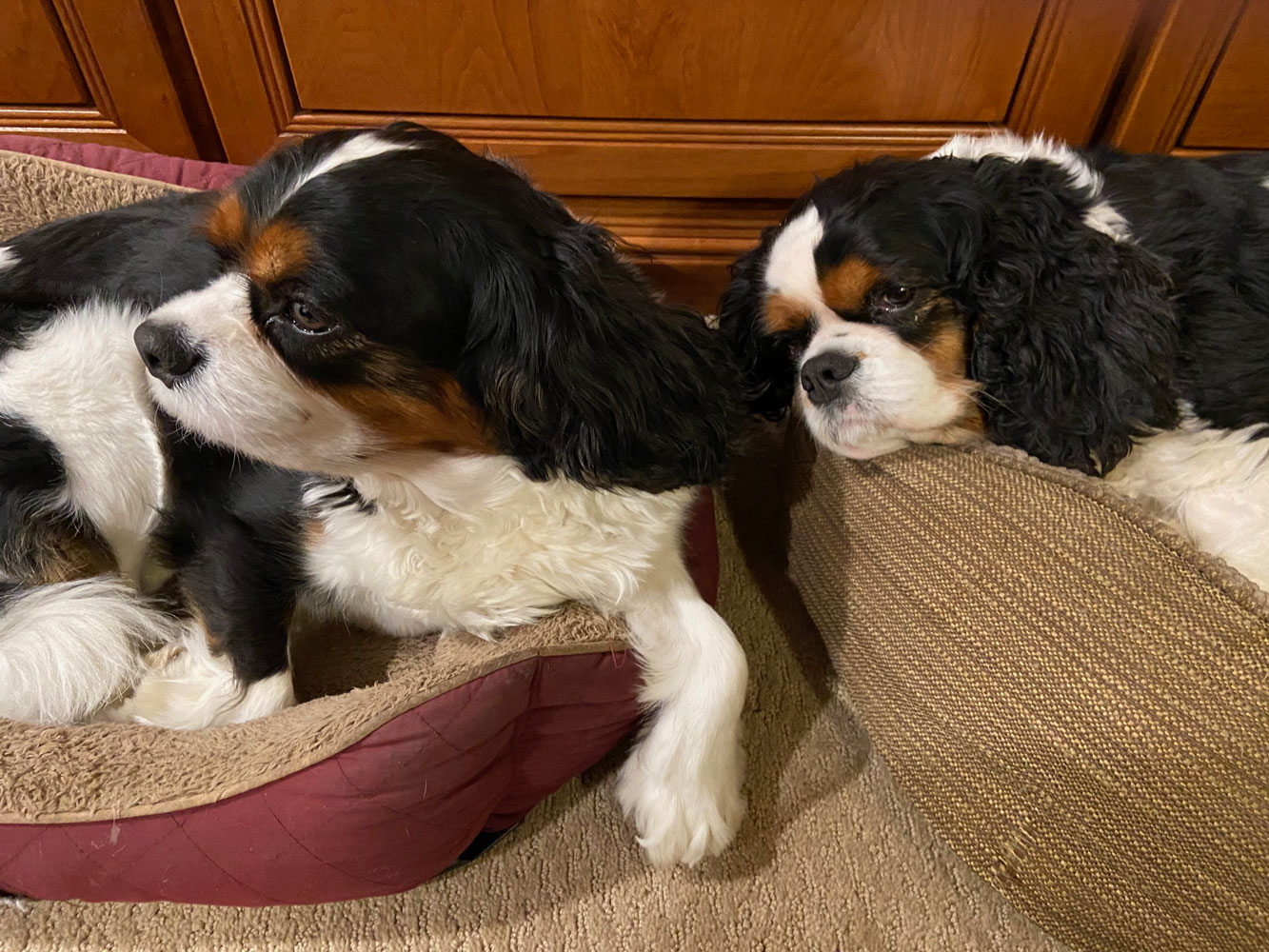
Here's our traditional pre-trip photo.
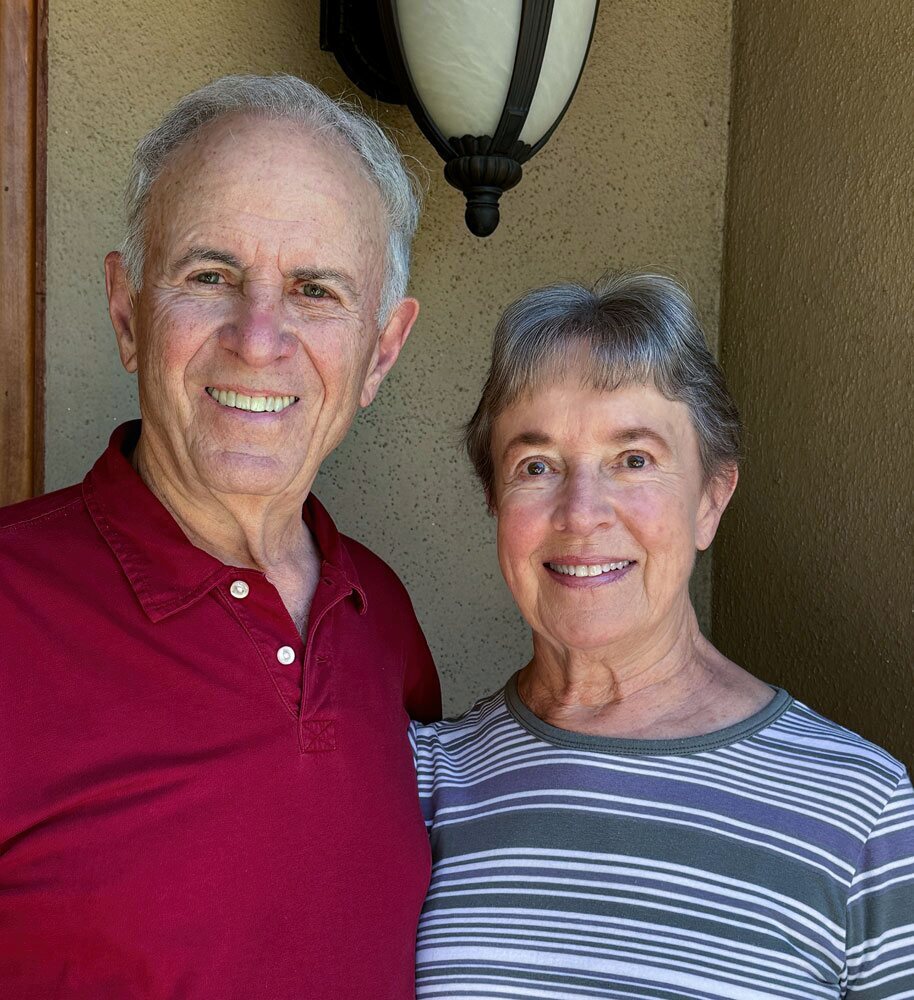
The limo driver arrived on time, about 1pm, and we were off. Lynn and Greg gave us a "military salute" as we left.
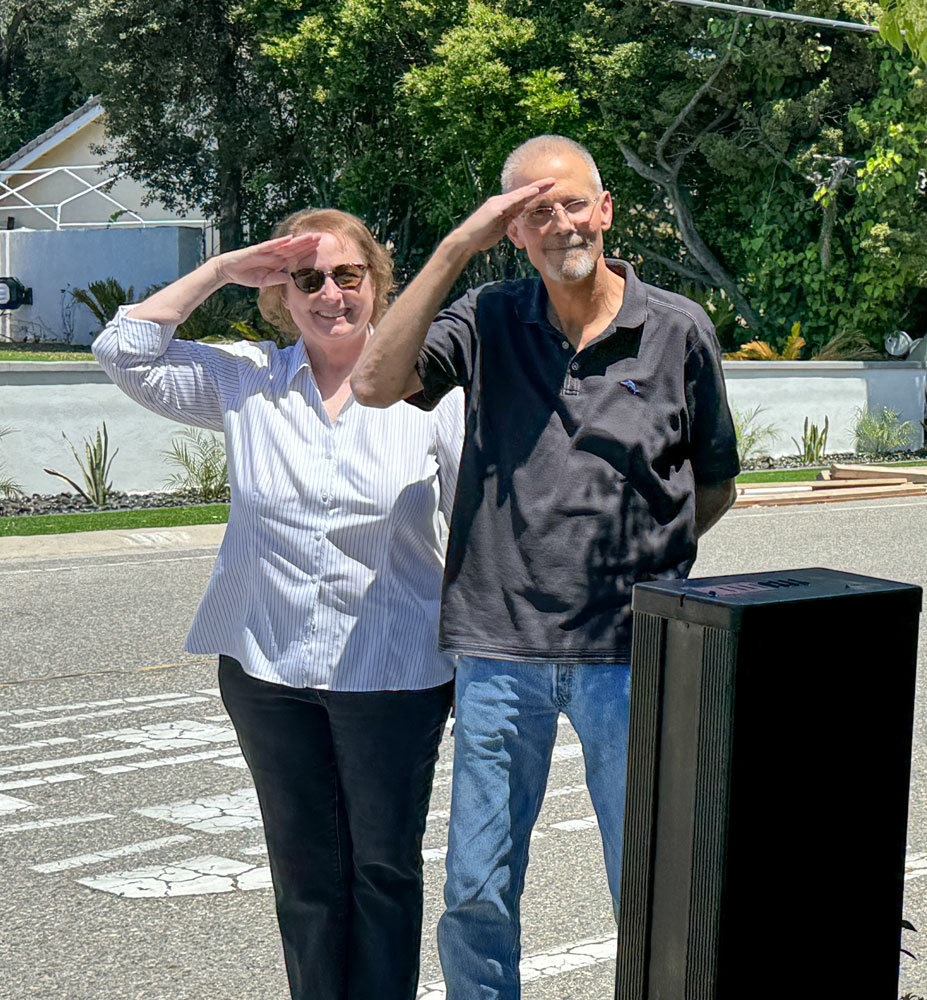
We had an interesting drive to the airport. Our driver, Armando, had been a photographer for the Orange County Register, the local newspaper, so we talked photography. Then, we discovered that his dad was from New Orleans and that lead to more conversation. Very interesting guy and, of course, a good photographer. Here's a link to his website and pictures. He's rebuilding it so there's not much on it now.
Here he is with Judy at the airport.

We were able to check in quickly.

Then we used "Clear" to clear security, and went to the business class lounge. At 4pm we went to the gate and boarded fairly quickly. The aircraft is an A380-800, which is a nice plane. Lufthansa's seating was fine.
We were scheduled to depart at 5:10pm, but, as usual, departure was late. We took off about 6pm.
They served us dinner and I watched the movie "The Zone of Interest" but didn't think it was that good. Then we tried to sleep. It was a 10.5 hour flight to Munich.
+++++++++++++++++++++++++++++++++++++++++
April 30, 2024 (Tuesday) We arrived in Munich essentially on time, even though we departed LAX a bit late. I think the airlines add some time to their schedules to account for departure delays.
By the time we got through passport control in Munich, it was only about 30 minutes to boarding for our Athens flight, so we went directly to the gate.
The aircraft was an A321, configured in business class with regular economy seats, but with the middle seat blocked off. It was about a two hour flight to Athens, and we arrived about 6:45pm Athens time (an hour later than Munich).
This view was taken as we were nearing Athens. It might be of Piraeus.

A few words about ancient Greece and Athens. Many of our ideas about democracy originated in Greece. In 499 BCE, the Persian Empire under Darius the Great, and after his death under Xerxes I, attempted to conquer what is now called Greece, initiating the Greco-Persian wars. Many of those battles reverberate to today, especially the stand of the Spartans at Thermopylae, the naval Battle of Salamis, and the Battles of Marathon and Plataea. The Battle of Plataea put the nail in the Persian's coffin and ended the war. If the Greeks and their allies had not prevailed, Europe might have developed in a very different fashion.
I would encourage you to read the history of that time - it's very interesting.
[Side note: Alexander the Great returned the favor a century or so later by conquering Persia in 336 BCE.]
When we got to Athens, there was a Tauck representative who met us at the baggage claim carrousel with a luggage carrier, which was nice because Athens charges 1€ for a luggage cart. That was really appreciated - thanks, Tauck!
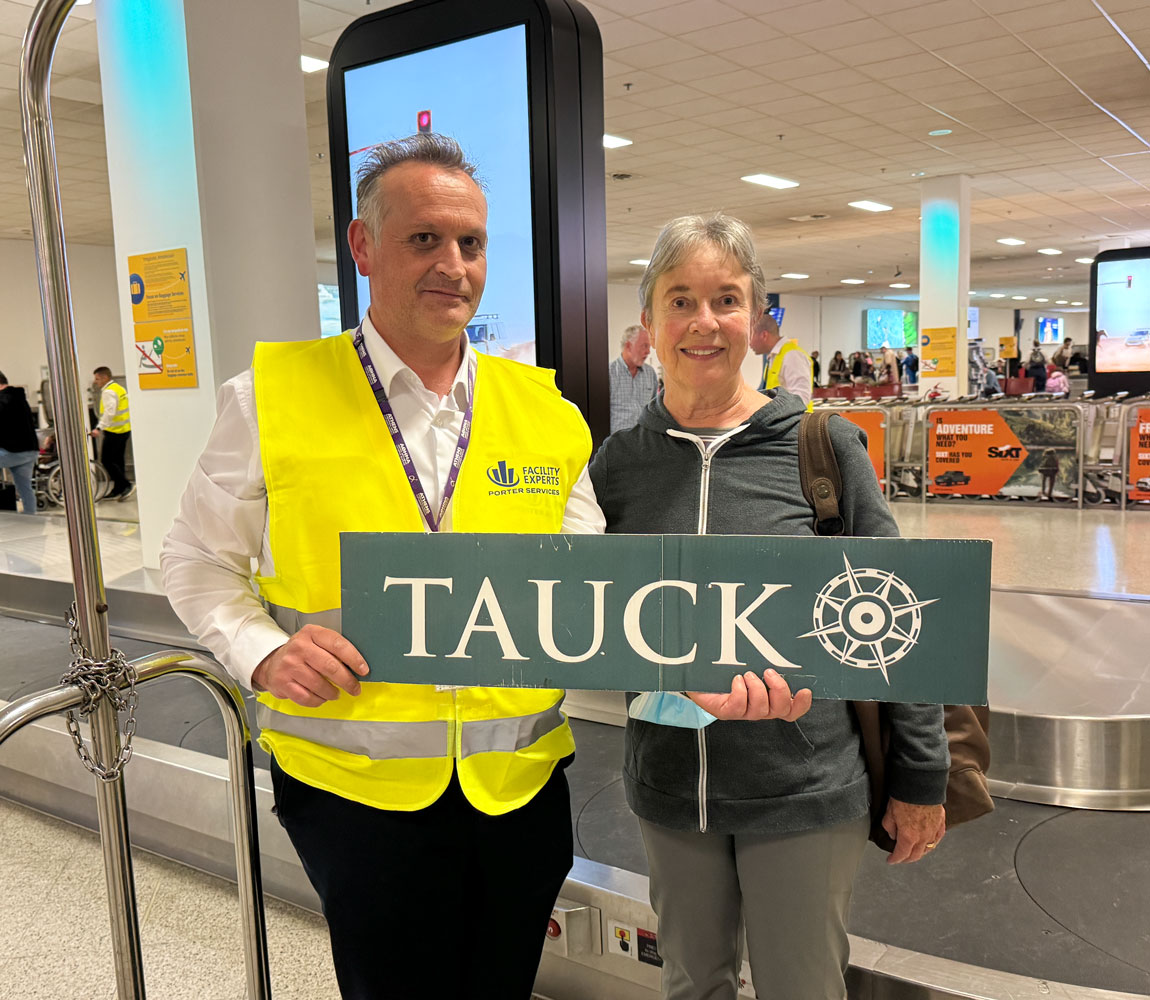
The ride to the Hotel Grande Bretagne (Grande-Bretagne is French for "Great Britain") was about 45 minutes, with rush hour traffic in the last part of the trip. We arrived about 8pm.
It's an elegant hotel, old - the driver told us it opened about 1850. I'll get a picture of the exterior tomorrow. [Update] I did some research - the original part of the hotel was built in 1842 and it has been expanded several times since then. It didn't have electricity until 1888. Judy likes these old hotels - I prefer more modern hotels with larger rooms.
Here's a picture of the exterior, taken on May 1. Next door, on the left in this picture, and attached to the Grande Bretange, is the King George Hotel, sister hotel to the Grande Bretange, and also a Marriott Luxury Collection Hotel . I don't know if there is an internal connection between the two hotels.]

A view of the lobby.
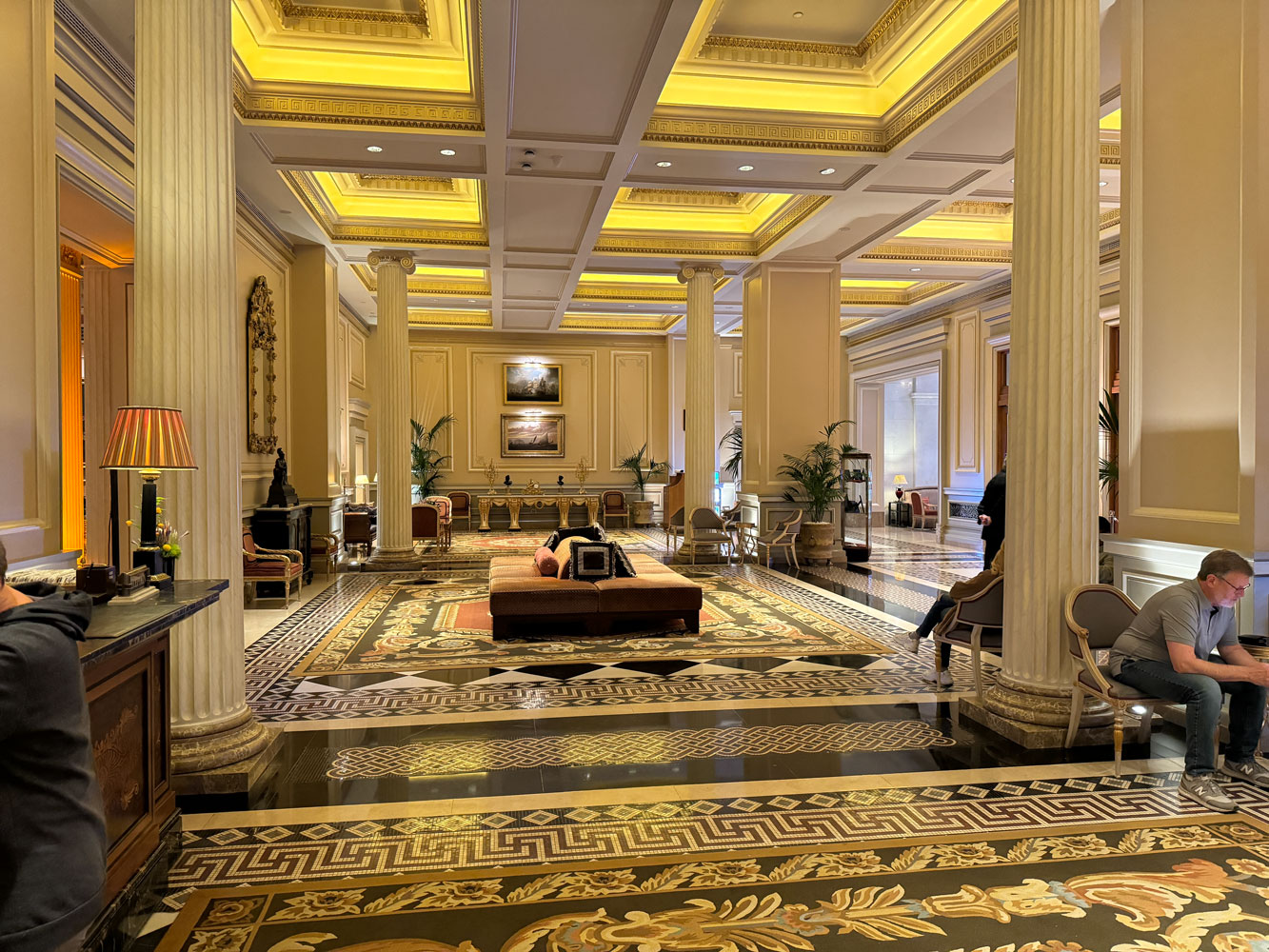
And the reception desk, as we were checking in. The woman at Reception was very nice, going over everything in detail, and closing with a comment that she was giving us an upgraded room.
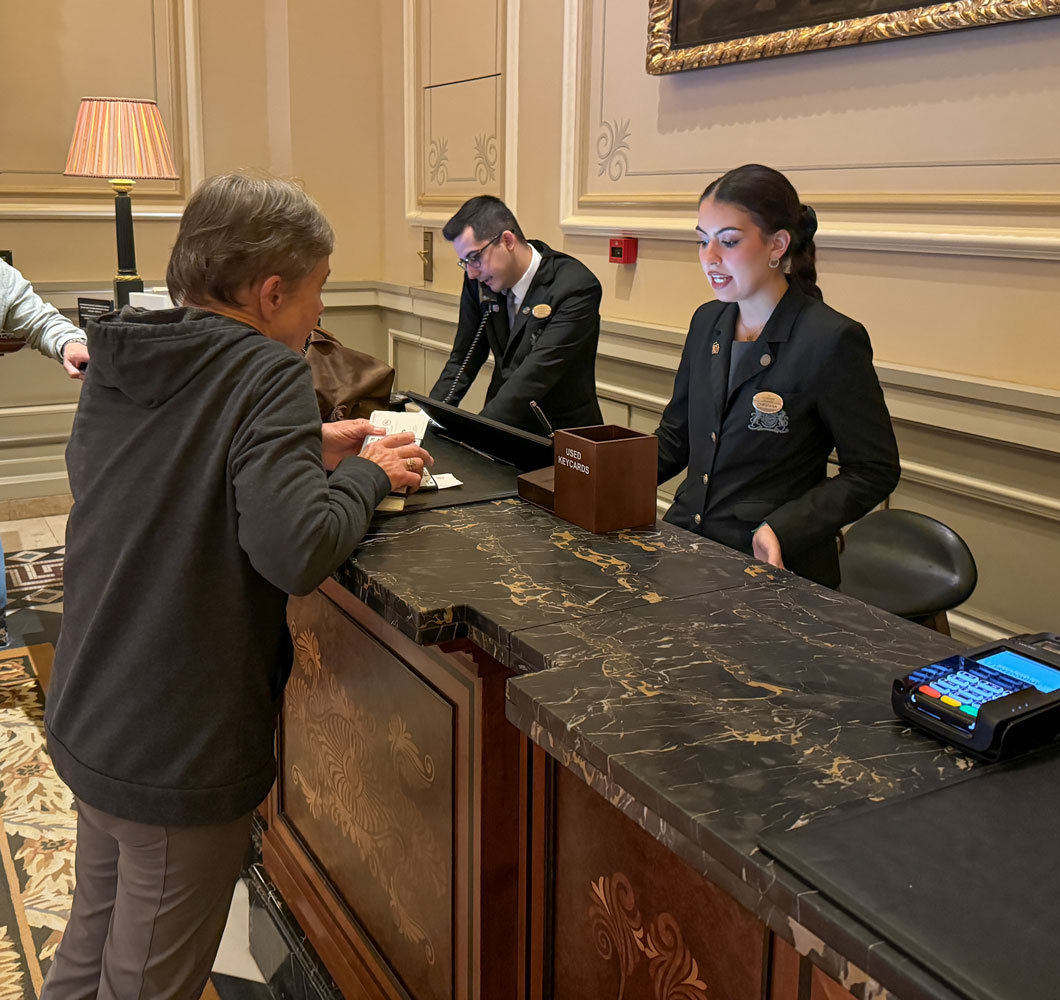
Our room is nice but somewhat small, which is true for most older hotels, and it has a tub shower, which I consider a real negative compared to a walk-in shower. We're getting older and it's too easy to slip and fall getting in and out of a tub. Just standing on that slippery round bottom of the tub leaves you unsteady, and they don't even have a grab bar in the shower. I'll take comfort and safety over charm any day.
One nice thing about the bathroom was that the mirror was heated so it didn't fog up after you took a shower.
I believe the room upgrade was to a room facing out from the hotel, instead of facing to an interior courtyard, and the room was located on a floor where the rooms had balconies.
Here are a couple of views of the room.
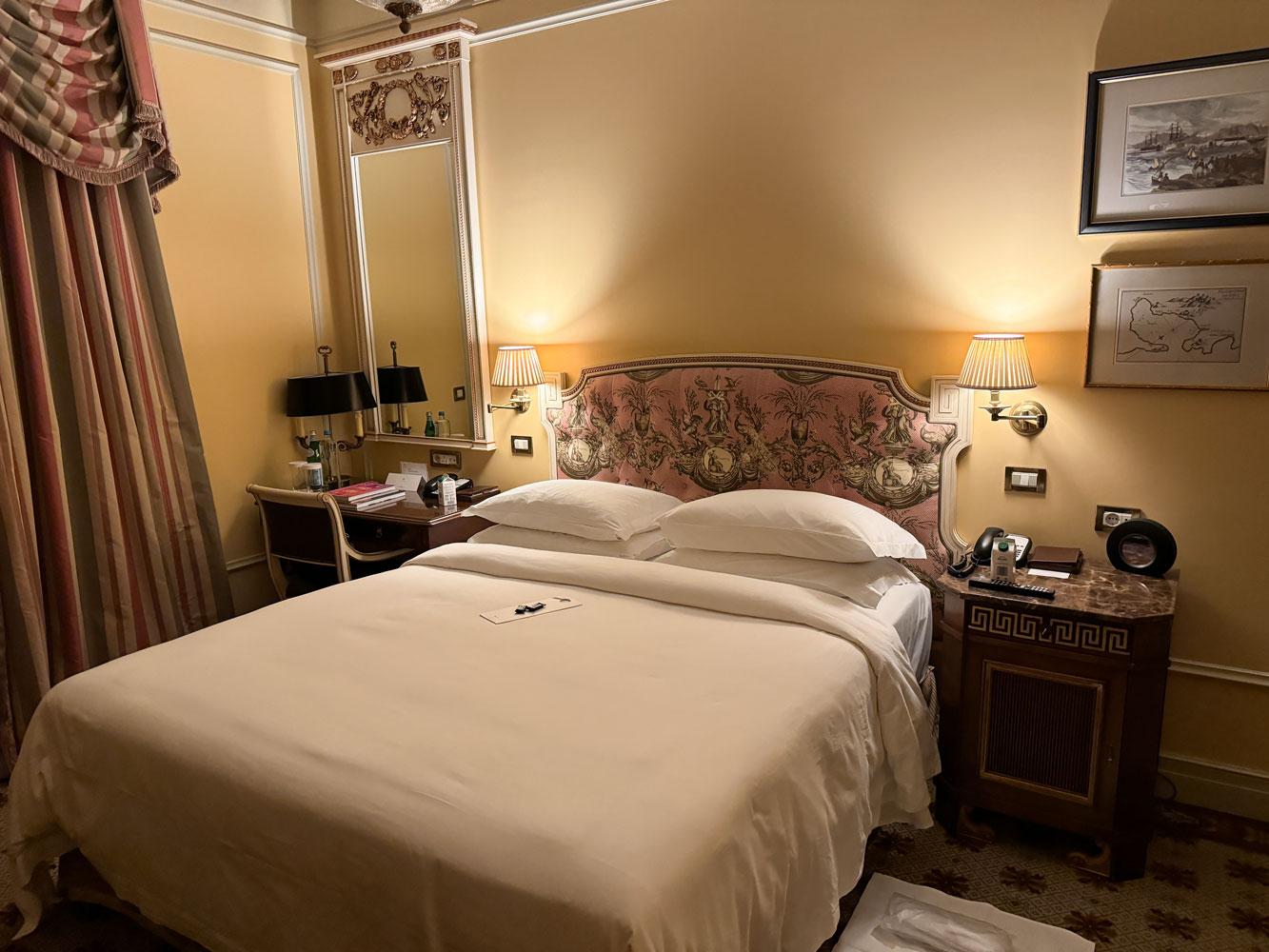
Another view, which does a better job of showing its size.

But other than the smaller size and the tub shower, the room is very nice. Well appointed, and with the amenities you'd expect in a luxury hotel.
A night time view out of our balcony door, with the Parliament building on the right. It used to be the Royal Palace but was converted to the Parliament building in 1934.
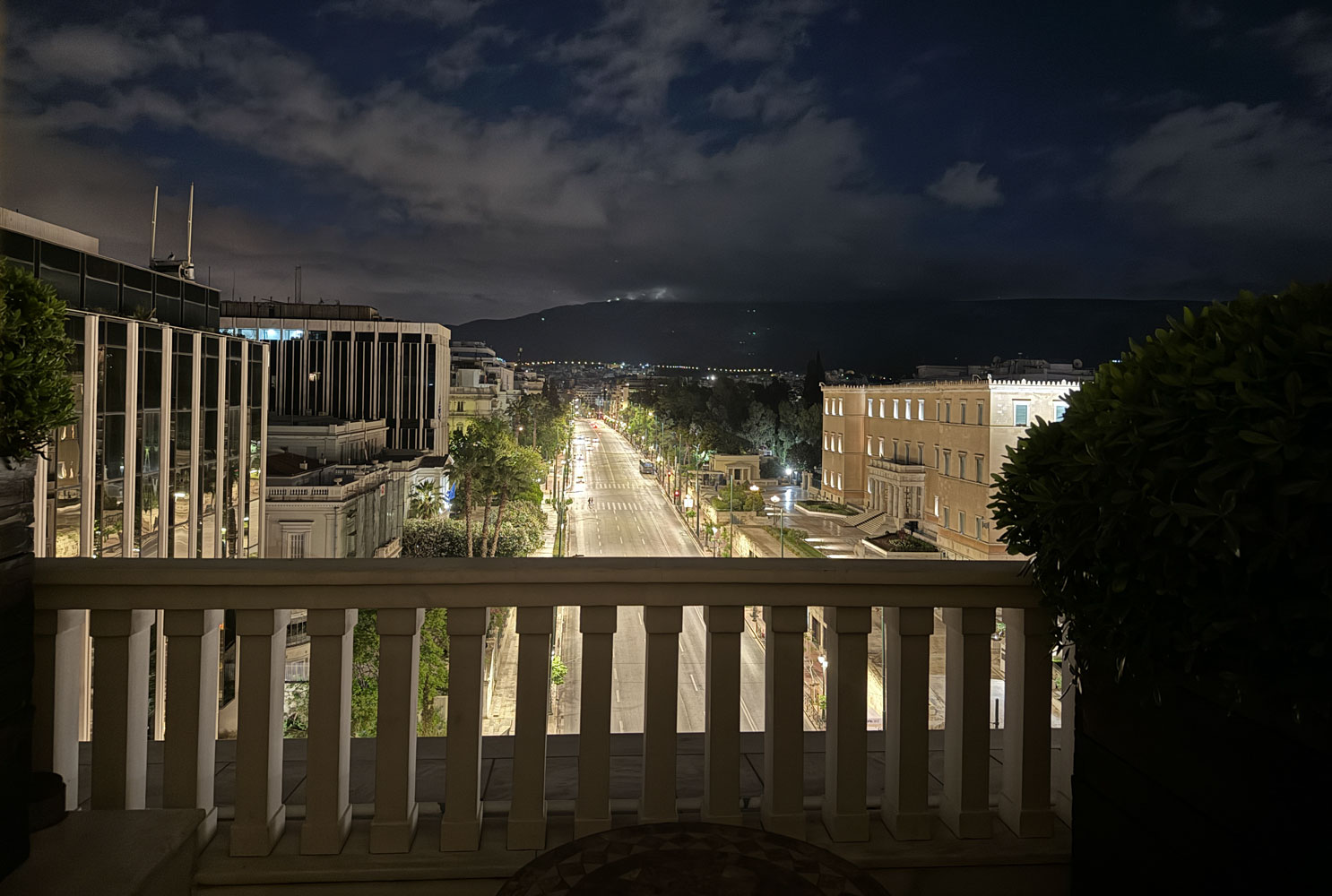
After the long trip, we went to bed, in hopes of sleeping through the night.
++++++++++++++++++++++++++++++++++++
May 1, 2024 (Wednesday) May 1st is Labor Day in Greece (May Day). I noticed a sign in the hotel lobby that there will be a demonstration in front of the hotel starting at 9am.
Incidentally, the "Mayday" distress word does not come from "May Day". It comes from the French "m'aidez" (help me) or "m'aider," short for "venez m'aider" (come help me).
We slept until 5am this morning. Today is a free day for us, but the Tour Director, Michael Furillo, is going to lead a walk around the area this afternoon for those of us who arrive early. He'll repeat it on Thursday morning.
We went to breakfast at the restaurant on the 8th floor. From there, you can see the Acropolis of Athens and the Parthenon located there. This is a picture of the restaurant on the 8th floor of the hotel. You can barely see the Acropolis in the distance. It's a very nice restaurant with a good breakfast buffet.
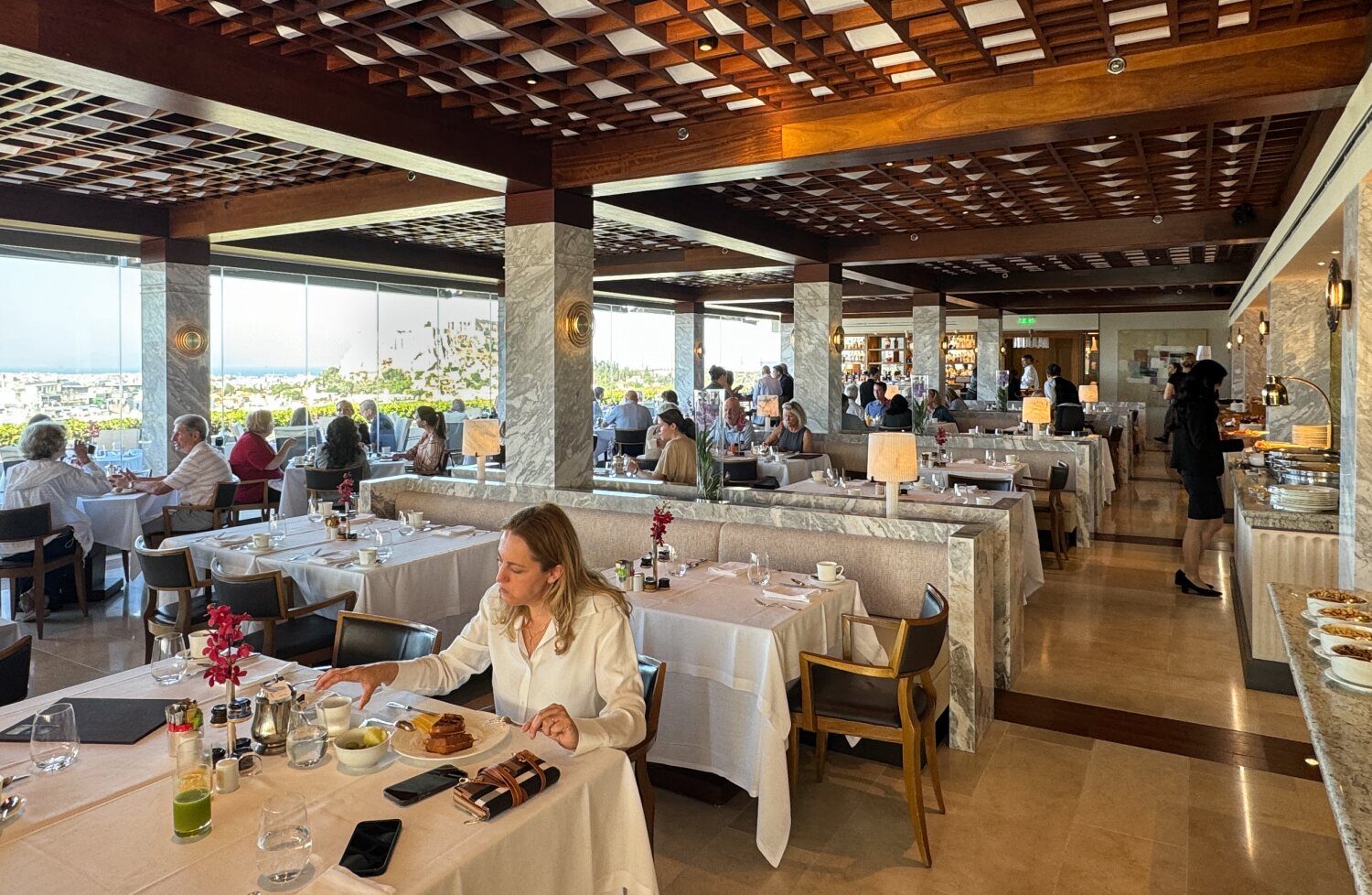
Here's a picture of the Acropolis and the Parthenon, as seen from the restaurant.
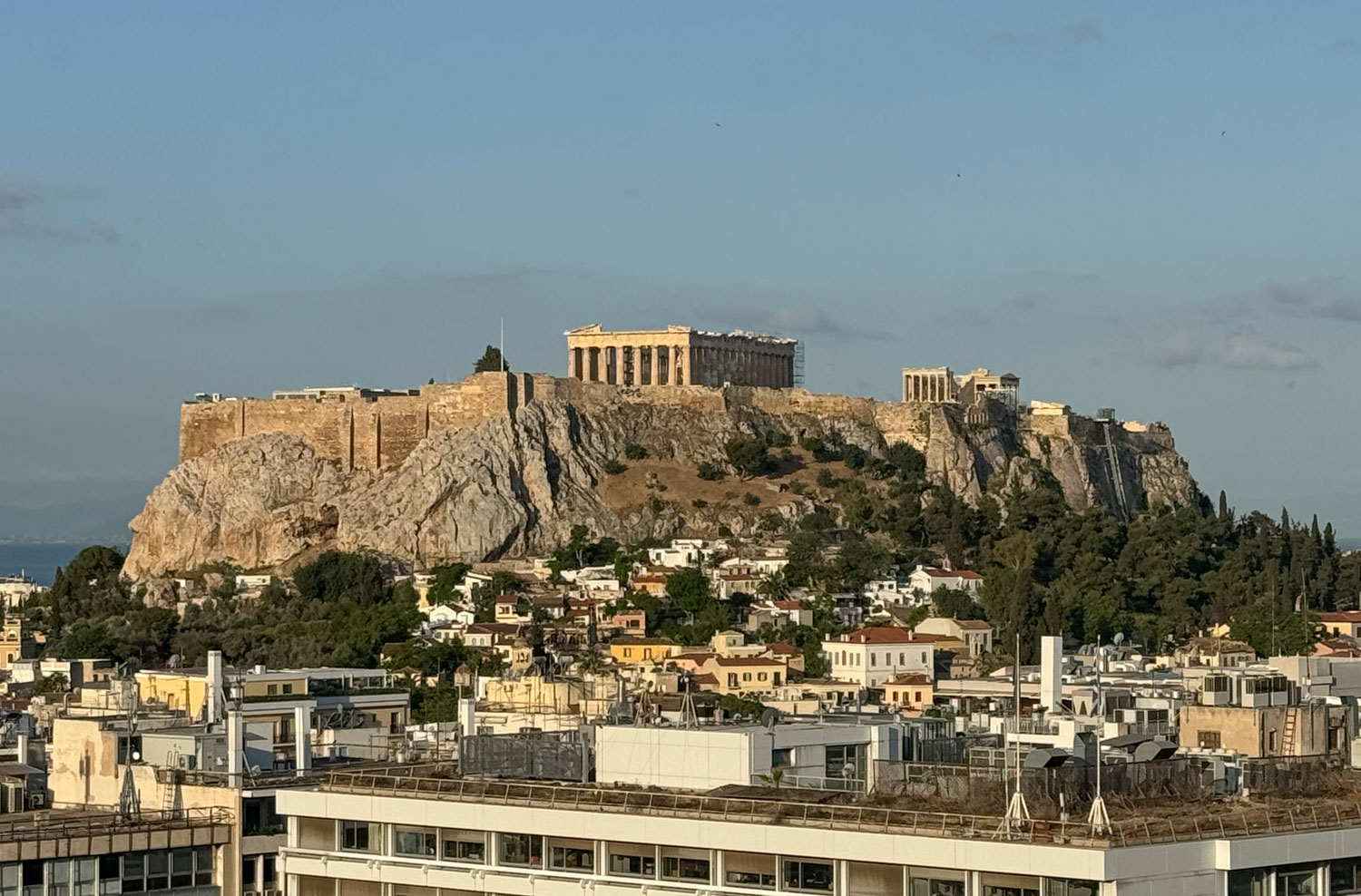
The Parthenon is ancient, having been built in the fifth century BCE (about 438 BCE) and was dedicated to the goddess Athena. It went through a lot, being converted to a Christian church in the 6th Century CE, and then after Athens was occupied by the Ottoman Empire in the 15th Century, it was converted to a mosque.
The Parthenon was severely damaged in 1687, during the Morean War between the Venetians and the Ottoman Empire. The Ottomans used the Parthenon to store gunpowder. A Venetian mortar round blew up the gunpowder, which severely damaged the Parthenon, leaving it without a roof. Here's a website that also shows what the Parthenon looked like in antiquity. Here's a link to a different site. You can find even more websites about the Parthenon with a Google search.
From 1800 to 1803, the 7th Earl of Elgin took a number of marble statues and friezes that had survived the blast and shipped them to England, with the permission of the Ottoman government. Of course, the Parthenon was not part of the patrimony of the Ottomans so they were not very concerned about giving the marbles away. Those marbles are now held by the British Museum and are known as the Elgin Marbles. Greece claims them as part of their heritage, while the British Museum maintains they stole them fair and square.
Here's Judy with the Acropolis in the background.

Here's a picture taken from the other side of the Acropolis - picture from the web. We'll visit the Acropolis on Friday. Look closely at the middle left side of this picture and you'll see a lot of people on the path to the Acropolis. Unfortunately, that's what we were to encounter during our visit.
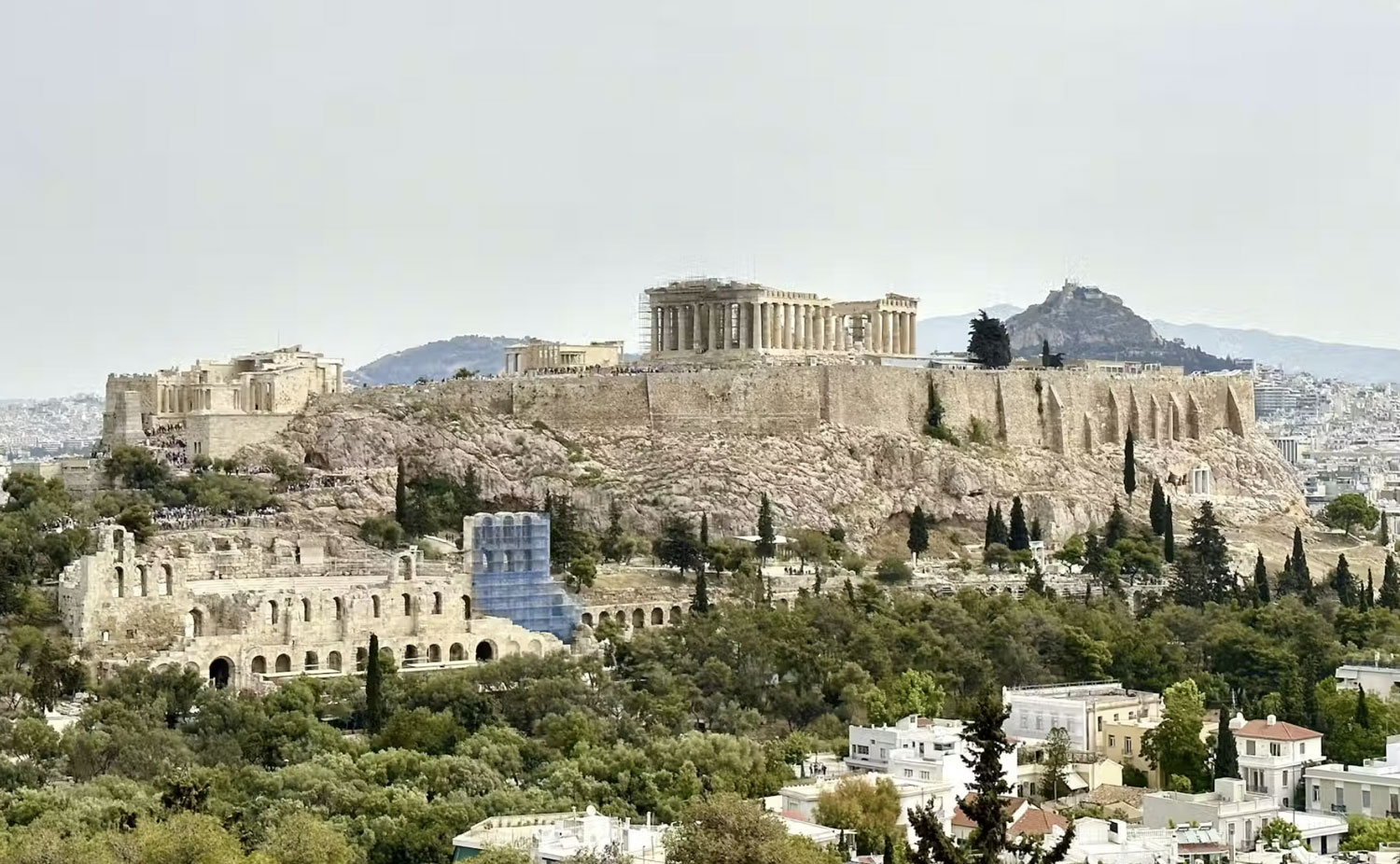
Here's an enlargement of that area of the previous picture. You can see the people going up the path, and the crowd on top of the Acropolis.
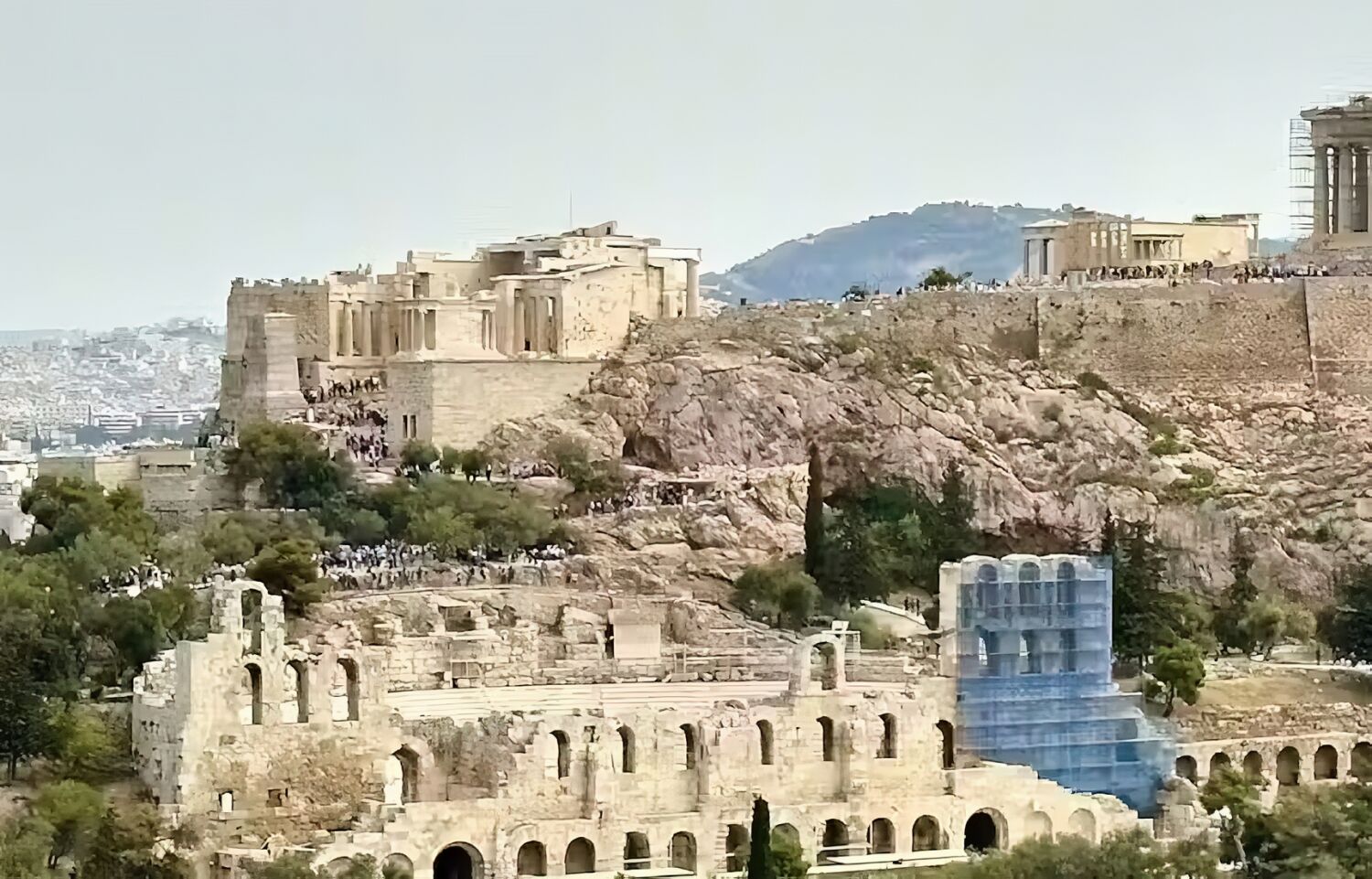
They should rebuild the Parthenon to its original glory.
The demonstration did begin about 9am in the area of the hotel. We have a balcony, but there's a lock on the door that prevents us from going out on the balcony, and to open that lock requires a key.
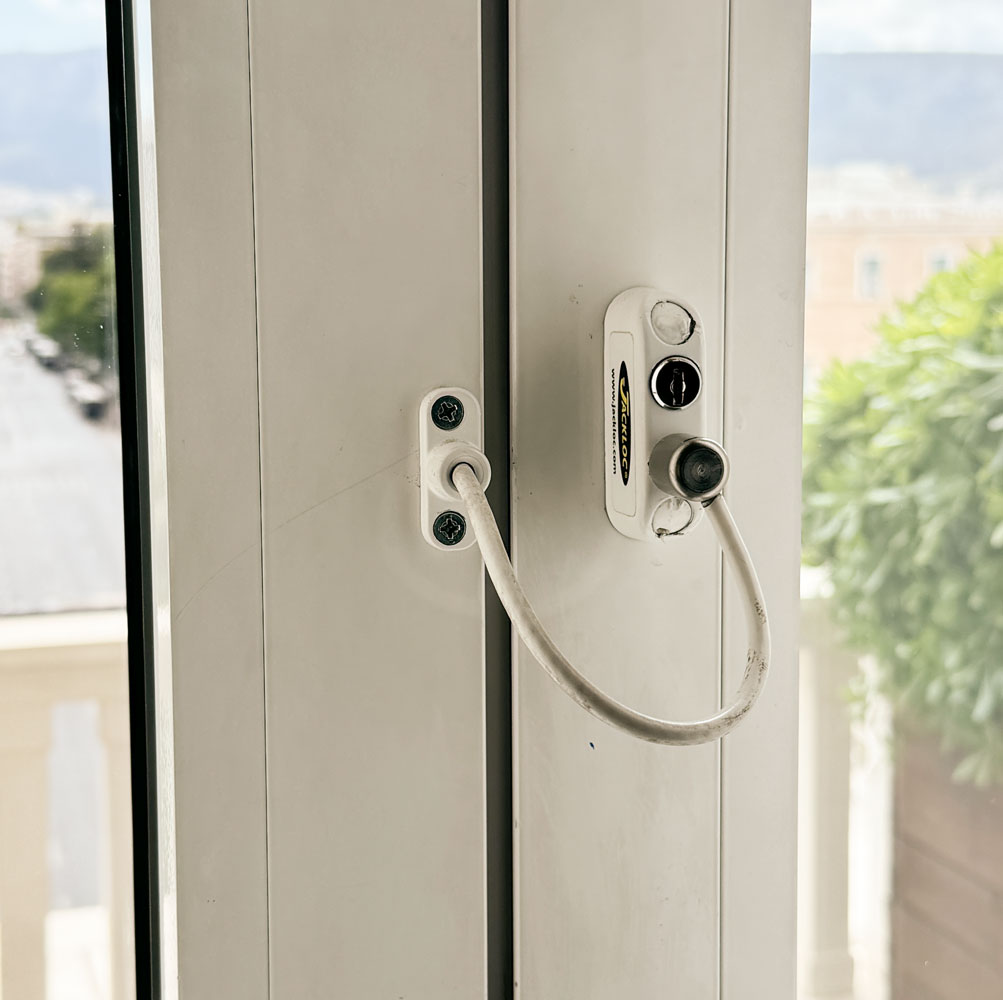
I made several requests to the hotel to open the lock, one to the porter who brought up our bags, one to the front desk, and one to the cleaning person. The porter and front desk assured me that someone would come up immediately to open the lock, but no one ever showed up. Eventually, it was the cleaning person who found someone to unlock it.
But in the meantime, being an engineer, I travel with tools. I removed the two screws from the part on the left and was able to open the door so that we could get out on the balcony.
Here's my travel tool kit. On the left is one of those "multitools". I got it primarily because of the hammer function. Next to it is a folding screwdriver kit. At the far right is a small folding scissors. The rest are standard tools. The scissors have probably been used the most.
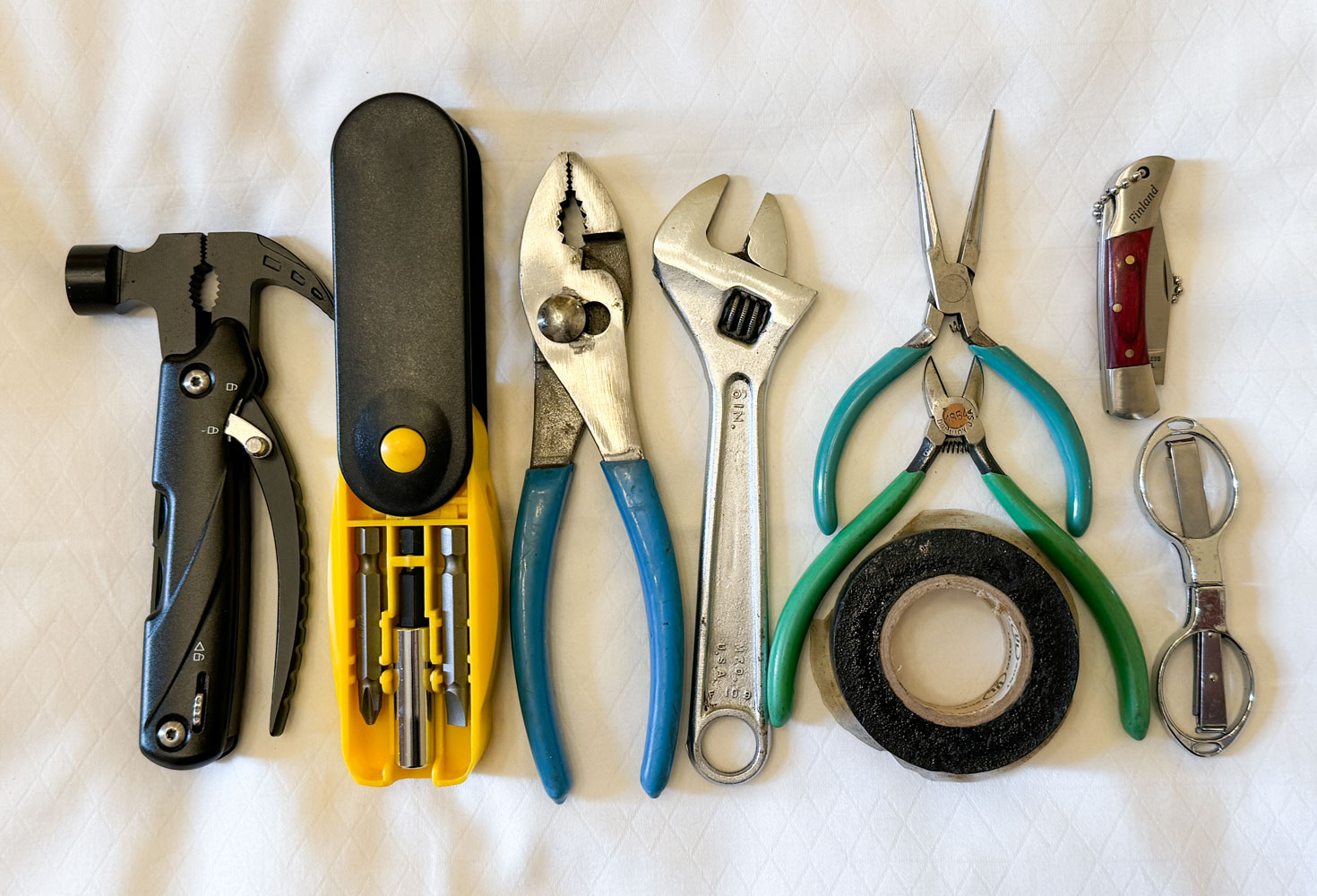
The hotel has not been very responsive to our requests. We asked twice for two luggage stands so that we wouldn't have to deal with our luggage being on the floor, and for a rubber mat for the tub to provide a bit more safety when we shower, but nothing has been done. I'll keep bugging them.
After I removed the screws on the lock, we were able to go out on the balcony and take pictures of the demonstration.
Here's an overall view of the demonstration. The police placed buses across the road to protect the demonstrators from any vehicles that might come down the road. That's the Greek Parliament building in the center of the picture. Maybe that's why they held the demonstration here, in front of the Parliament building.
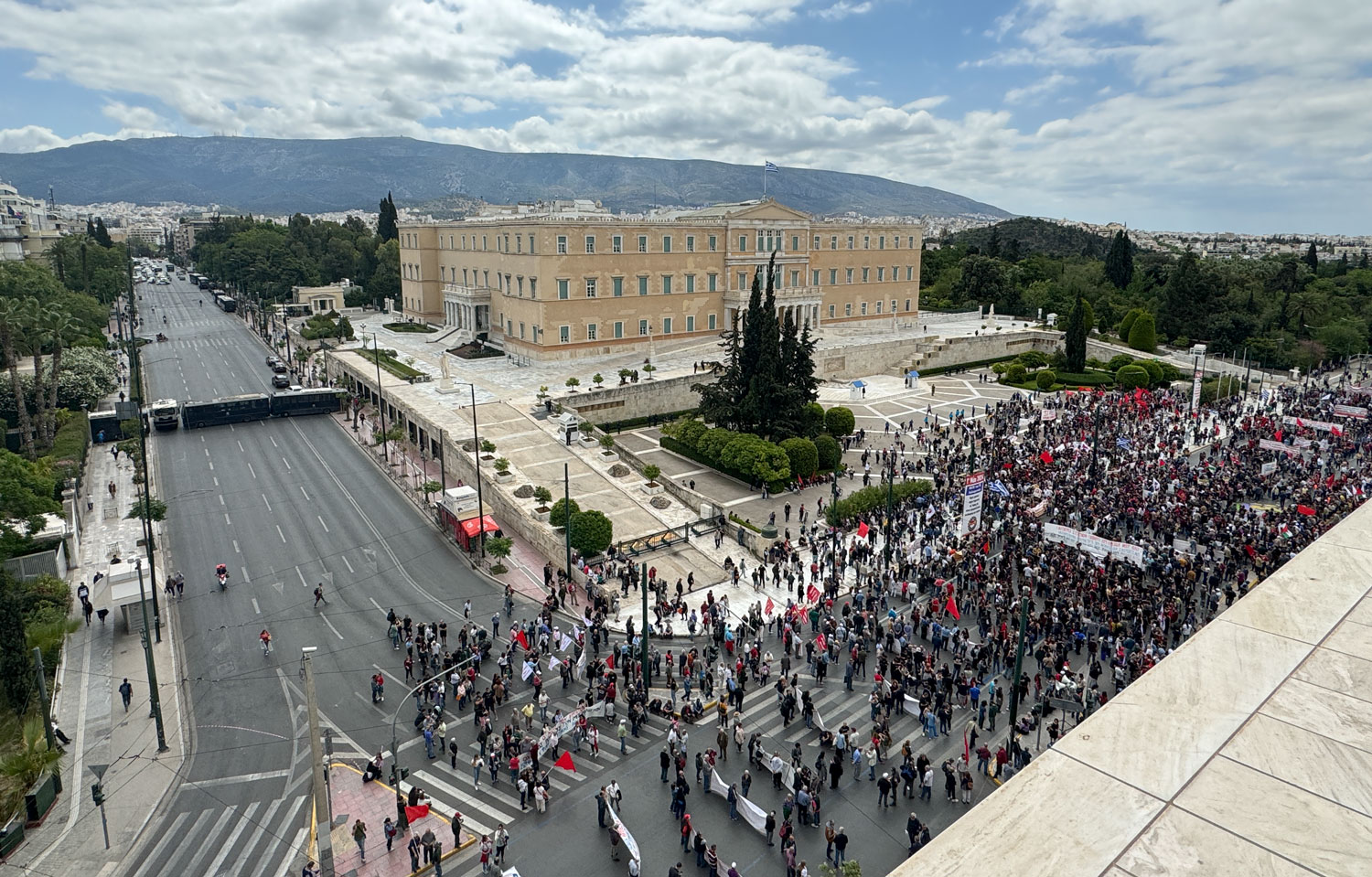
A closer view of the people at the demonstration. I'm not sure what the demonstration was all about - I did hear one of the speakers talking in English about the Israel/Hamas war and the plight of the Palestinian people - but I think the major theme was more local issues.
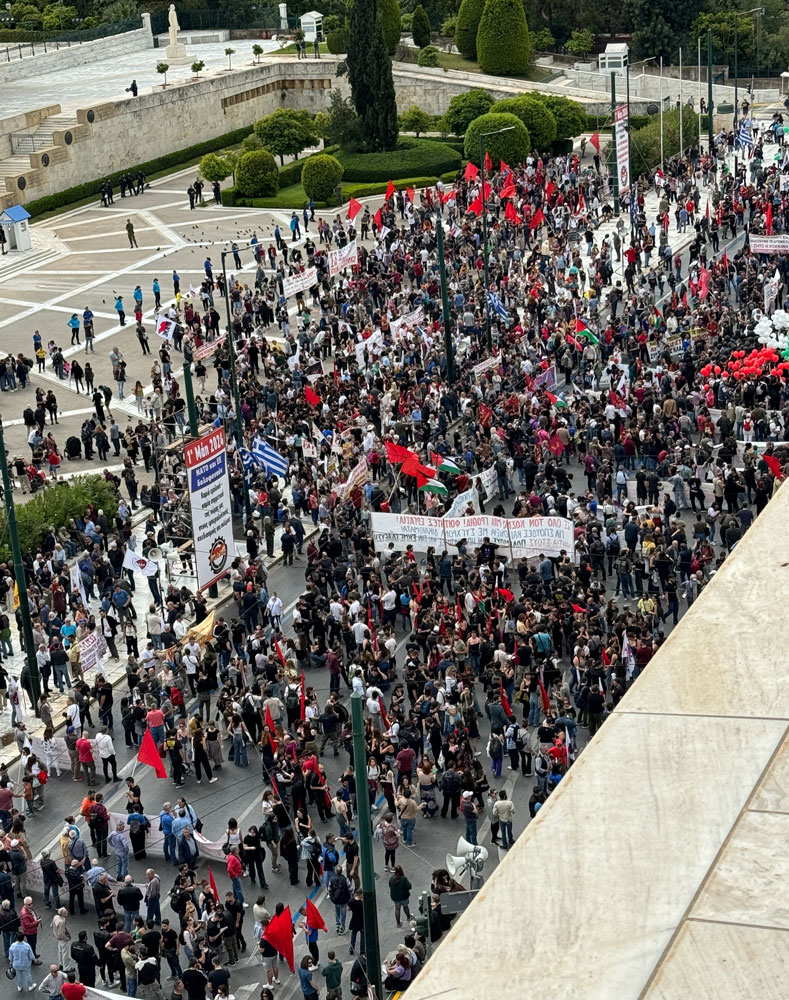
It was a beautifully clear morning, so Judy and I went for a walk in the area around the hotel. A number of the streets had been converted to pedestrian-only streets, so the walking was easy.
Mostly, it was various small shops, but at the end of Ermou street we found this ancient church.
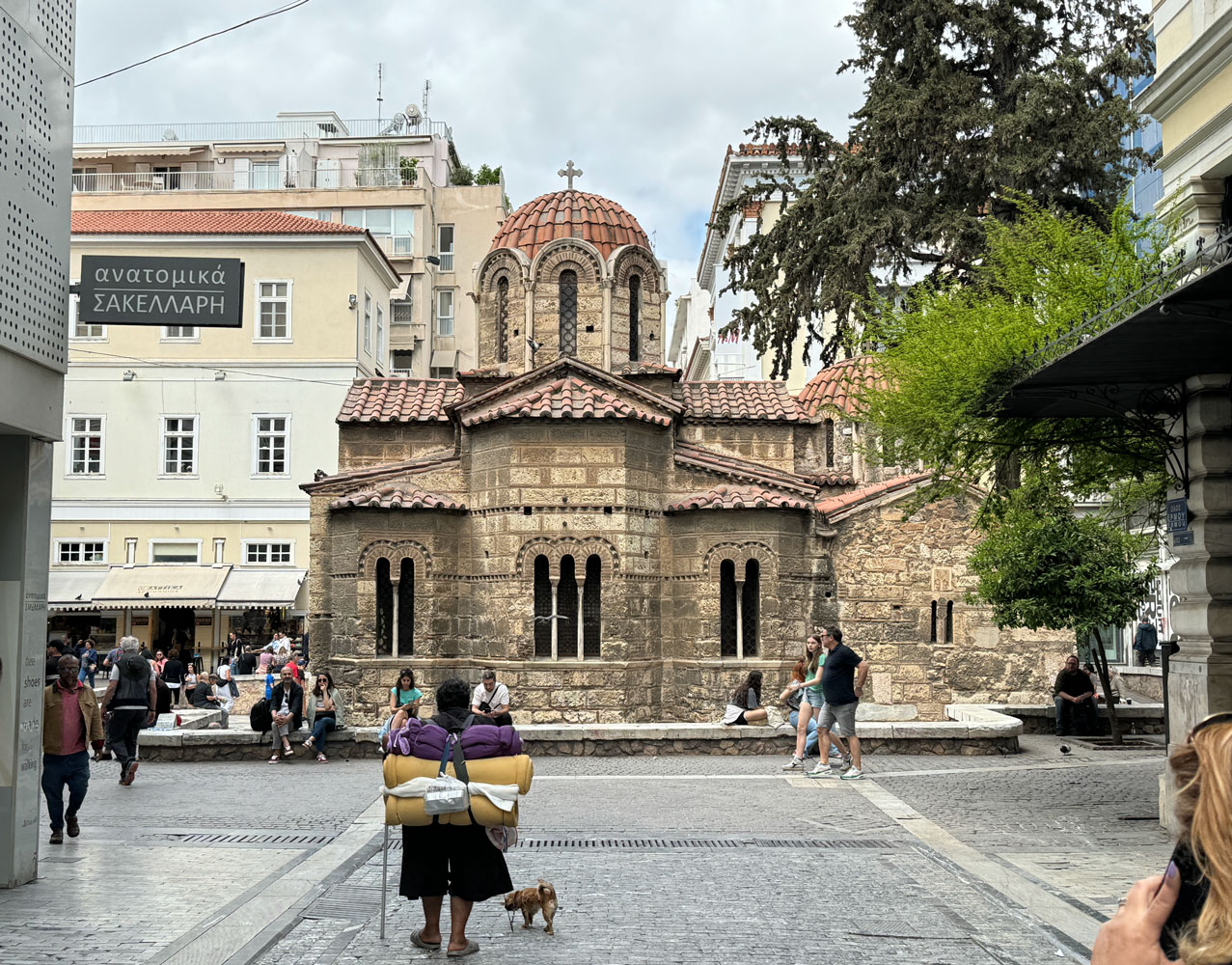
It has the long name of Holy University Church of the Presentation of the Virgin Mary - Panagia Kapnikarea - It was built about 1050.
By the time we got back to the hotel, the demonstration was breaking up.
We had a late lunch in the hotel, and then met Michael Furillo in the lobby a bit before 5pm. Here's Michael. This picture was taken at a later date. I had a hard time getting what I considered to be a good picture of Michael.

Most of the guests have not arrived yet, so there were only eight guests on the walk. I had gotten news from Tauck that VOX had a telecoil device that would work with hearing aids and they would make sure our Tour Director would have one for me to use. But Michael had never heard of it.
Aside: Tauck uses a device made by the VOX company that allows the tour guide to transmit his/her voice to each of the guests. VOX provides a small "earphone" that directs the sound into one ear. But the microphone on over-the-ear hearing aids is at the top of the ear so the hearing aid does not pick up the sound coming from the "earphone". I have complained to Tauck for years about this and they finally worked with VOX to provide a device which can work with hearing aids. [Update: unfortunately, the telecoil would not work with my hearing aids. Telecoil is a very old technology, used back with the old analog hearing aids. I'd like to see VOX provide an earpiece with the sound directed to the top of the ear, or a VOX unit that would implement Bluetooth to communicate with my iPhone. My iPhone can communicate with my hearing aids so I'd get the sound directly into my ears, and into both ears which would improve comprehension.
We went walking in the area around the hotel, initially duplicating the streets Judy and I walked in the morning. Here's Michael talking to us at the beginning of the walk.
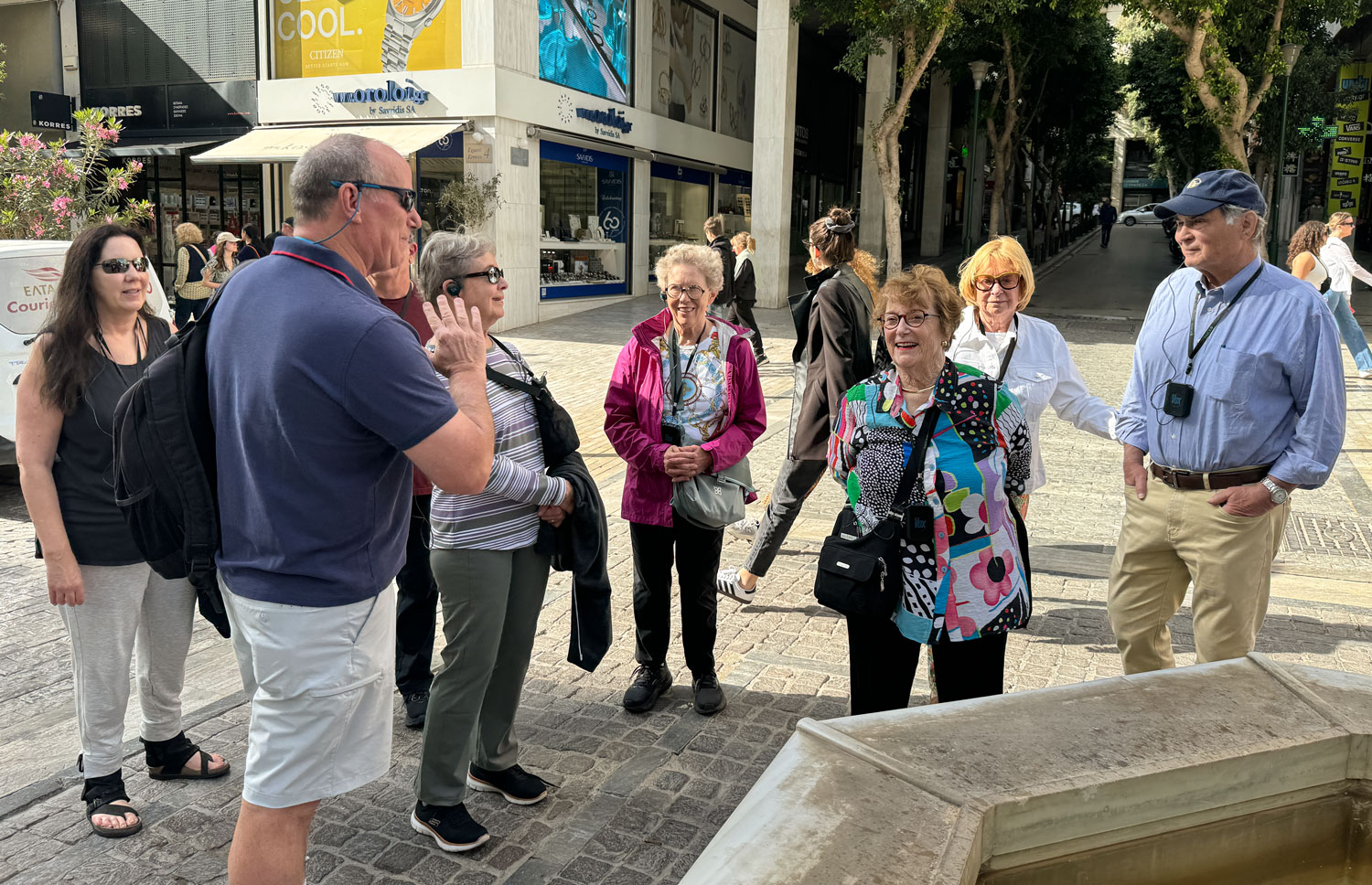
As we were walking, I saw this small church tucked under a large office building. It's the Holy Church of Hagia Dynamis (Sacred Power). They built the office building around the church.
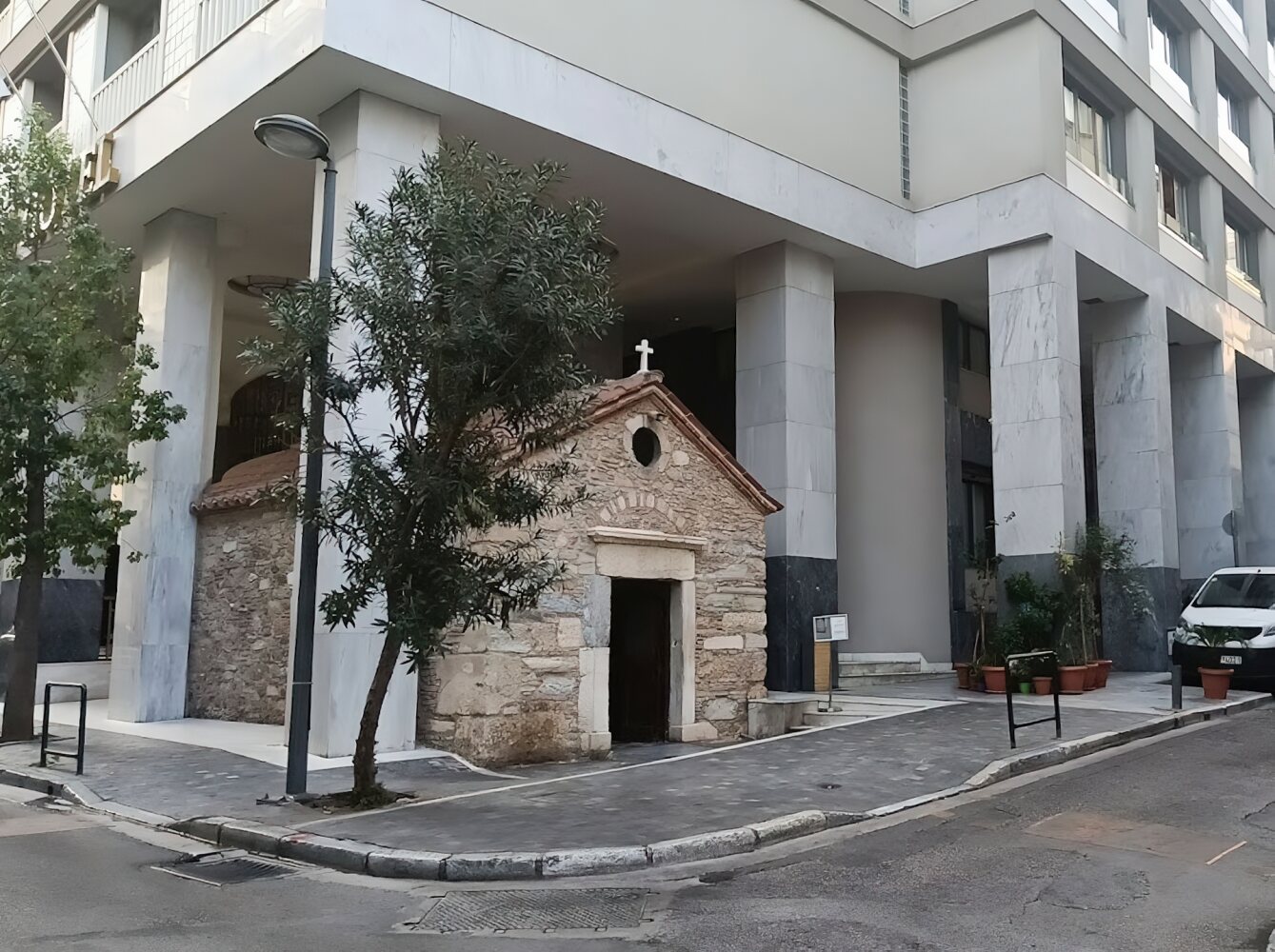
We walked to the Metropolitan Cathedral of Athens, known as the Holy Metropolitan Church of the Annunciation, located on Metropolis Street (the street takes its name from "Metropolitan"). The church was completed in 1862. We did not go in.

Essentially next door to the Cathedral is the Little Metropolis Church, Also known as the Church of Saint Eleutherius. It's a very small church and we did not go in.

Nearby was the statue of Constantine XI, the last ruler of the Byzantine Empire. The Byzantine Empire was essentially the Eastern Roman Empire. Constantine the Great established the city of Byzantium as the capitol of the eastern empire and later renamed it in 330 CE to Constantinople, after himself. He established the position of emperor as heredity, and many of the later rulers adopted the name of Constantine.
In 476 CE Rome fell and the Eastern Roman Empire was on its own.
Constantine XI was the last, and was killed in battle in 1453 during the Fall of Constantinople. The Byzantine Empire then became the Ottoman Empire.
The name of the city remained as Constantinople until 1930, when it was changed to Istanbul, as part of the formation of the Republic of Turkey.

We walked a bit further and Michael pointed out some recommended restaurants in the area. From one location, we had a good view of the Acropolis. Michael informed us that we would have to walk up to the top of it on Friday. There is an elevator, but it is limited to people in wheelchairs.
Also, because Friday is Good Friday before Easter in the Eastern Orthodox Church, the acropolis would not open until noon, which will complicate our visit. Note that the date of Easter is different in the Eastern Orthodox Church than it is in western Christian Churches. This is because the western Christian Churches use the Gregorian Calendar, while the Eastern Orthodox Church uses the Julian Calendar.
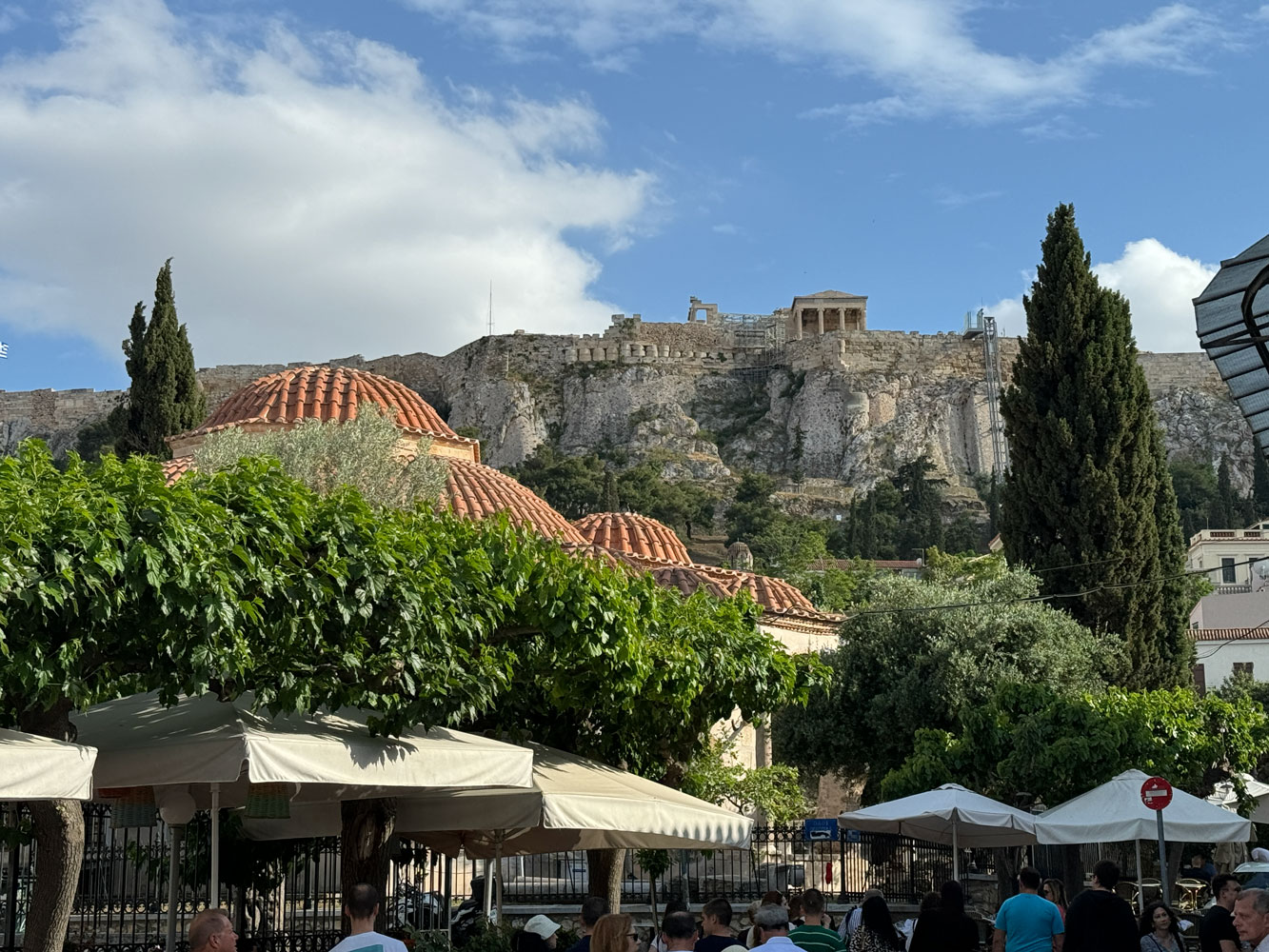
We continued our walk, with Michael pointing out interesting points of interest and restaurants, but eventually it was time for him to return to the hotel to take care of Tauck business. Judy and I continued walking in the area for a while but eventually made our way back to the hotel.
When we got to the hotel, we went to the front desk and for the third time requested two luggage stands and a rubber mat for the tub. Perhaps it was Judy's presence that made the difference, but soon after we got to the room, an employee showed up with the items.
That was the end of our day. We were not hungry since we had a late lunch, and went to bed, with the hope that we could sleep through the night.
But during the night Judy received an alarm on her phone that there had been an earthquake in southern California. We texted with our friend, Lynn, who was shaken up by the quake, but there was no damage. It was a small quake, about 4.1, centered 10 km southwest of Corona, CA, which is 16.5 km due east of Villa Park.
++++++++++++++++++++++++++++++++++++
May 2, 2024 (Thursday) The Tour officially starts today at 6pm with the Welcoming Reception.
We slept until a bit after 5am this morning and then went to breakfast at the rooftop restaurant. But when we got back to the room, we both took a long nap.
When we woke up, we went to the Museum of Ancient Greek Technology. It was just a short walk from the hotel. It's a fairly small museum. There were two floors open and they weren't that wide.
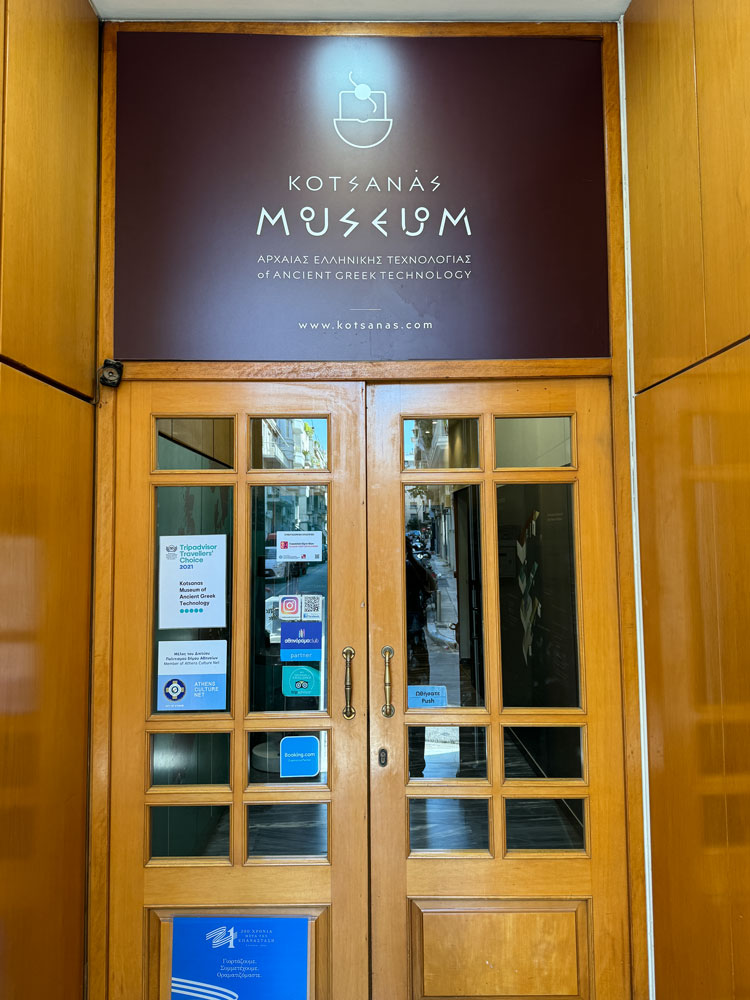
Their exhibits were divided into three sections: mechanical devices, musical instruments and weapons and armor. The charge was divided by section. You could purchase a ticket for one section for 5€ or the whole place for 10€. We decided to see the whole place.
I took a lot of pictures but will only put a representative set here. Here's a bow lathe for turning wood. The rope of the "bow" is wrapped around the shaft so that when the bow is pulled back and forth, the work spins. As the bow is pushed and pulled, the work rotates is opposite directions, which makes it difficult for the person doing the work.
And one hand has to be used to operate the bow, leaving only one hand to hold the tool.
A somewhat similar lathe was used in the early US. A turner would go from town to town and offer his services for turning work. But instead of a bow, he would set up next to a decent sized sapling tree. The tree would be bent over and a rope attached to the top. The rope would then be wrapped around the shaft, and finally connected to a board close to the ground.
The operator would cause the shaft to rotate in one direction by stepping on the board. When he let up on the board, the sapling would spring back up, rotating the shaft in the opposite direction. This was called a "pole lathe" and was invented in multiple places.
The tool used was usually a skew.
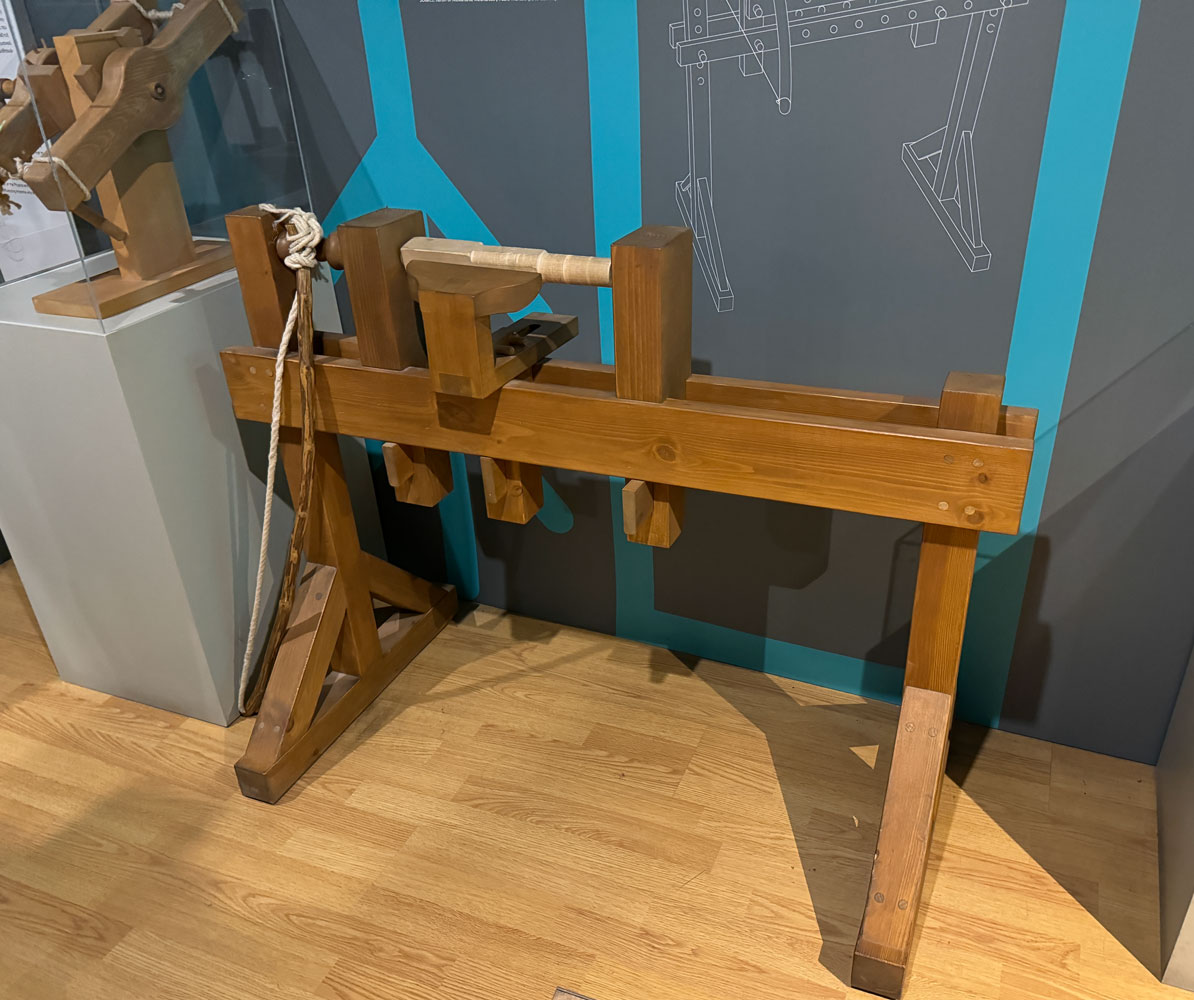
Some re-enactment woodworkers in the United States have made such devices.
Here's an Aeolipile, a reaction steam device, often described as the first steam engine. The lower container was filled with water and a fire built under it. The ball at the top was free to spin. As steam was emitted from the tubes on the top ball, the ball would spin. Unfortunately, it was just a demonstration device - it could not be harnessed to power manufacturing equipment.
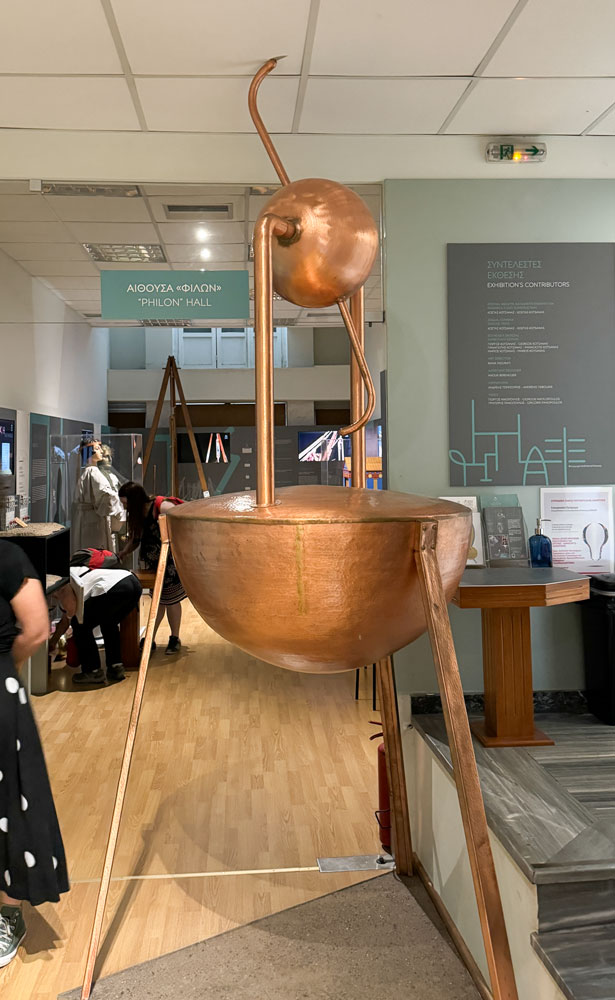
A vending machine cut-away. When a coin was inserted in the top of the jar, it would dispense a certain amount of liquid (maybe wine) into the cup on the right.
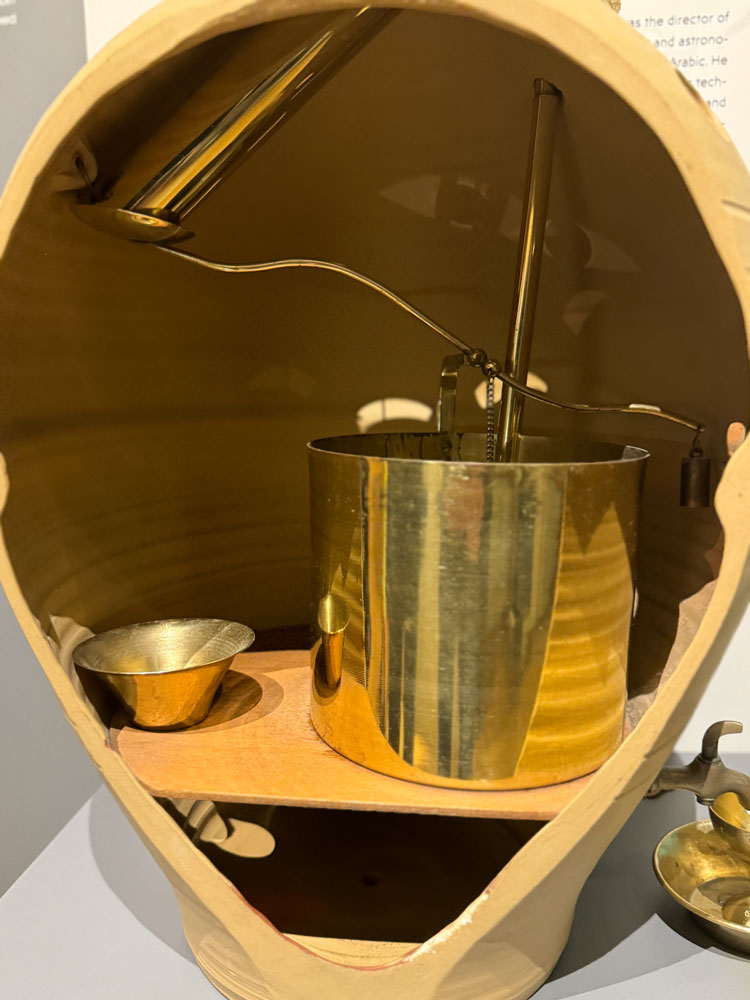
Many of these machines were invented by Heron of Alexandria (also known as Hero of Alexandria), but it appears that they were just novelty items - they were never used in general society.
There were many other devices, including one that would open the doors of a interior part of a temple, initiated by the lighting of a fire. The description said that the priests needed to show a connection to the gods. After a sacrifice they would light a fire in front of the altar. The fire would initiate a mechanism that would cause the doors to open, apparently with no human involvement. When the fire was extinguished, the doors would slowly close.
The priest could make statements, such as, "Zeus, if you are satisfied by this sacrifice, open the doors", etc.
There were some time keeping devices, and astronomical observation devices.
Then we went to the musical instrument section. Here's a water organ. I didn't really take the time to understand how it worked.
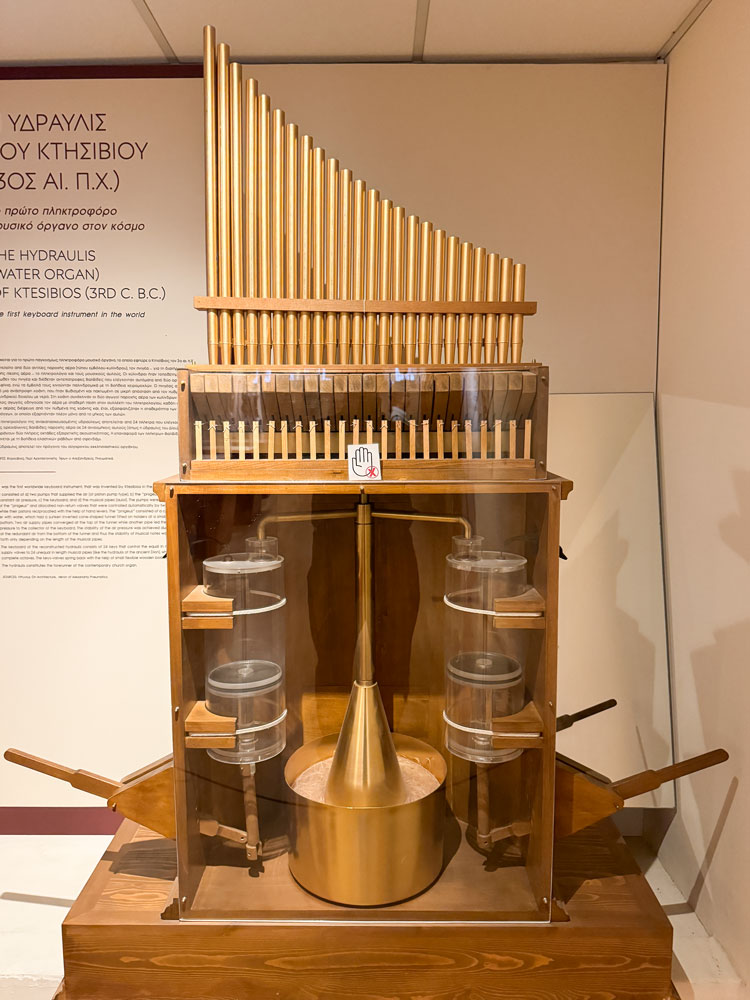
The music it played.
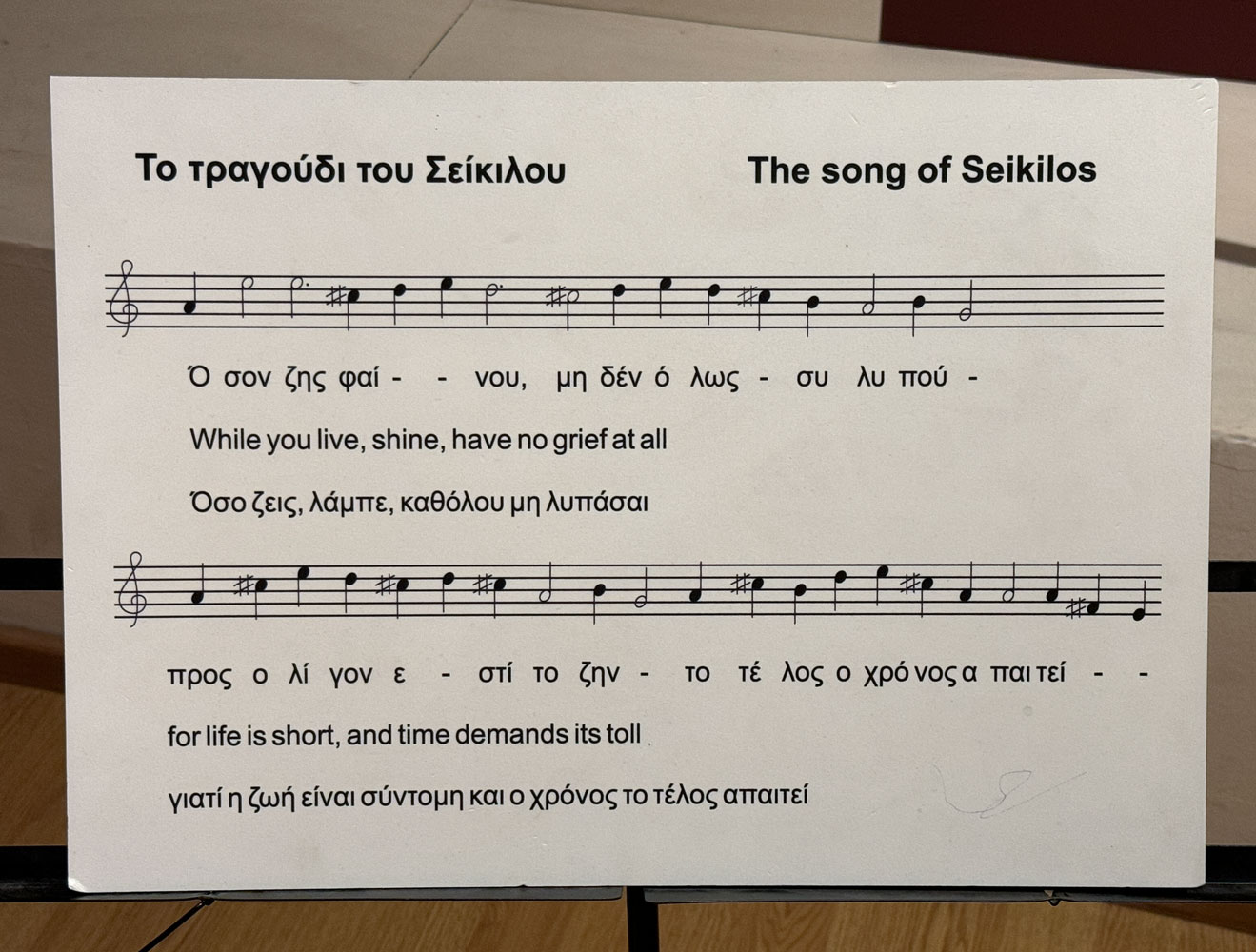
Here are some lyres. They had many different kinds of lyres.

Percussion instruments.
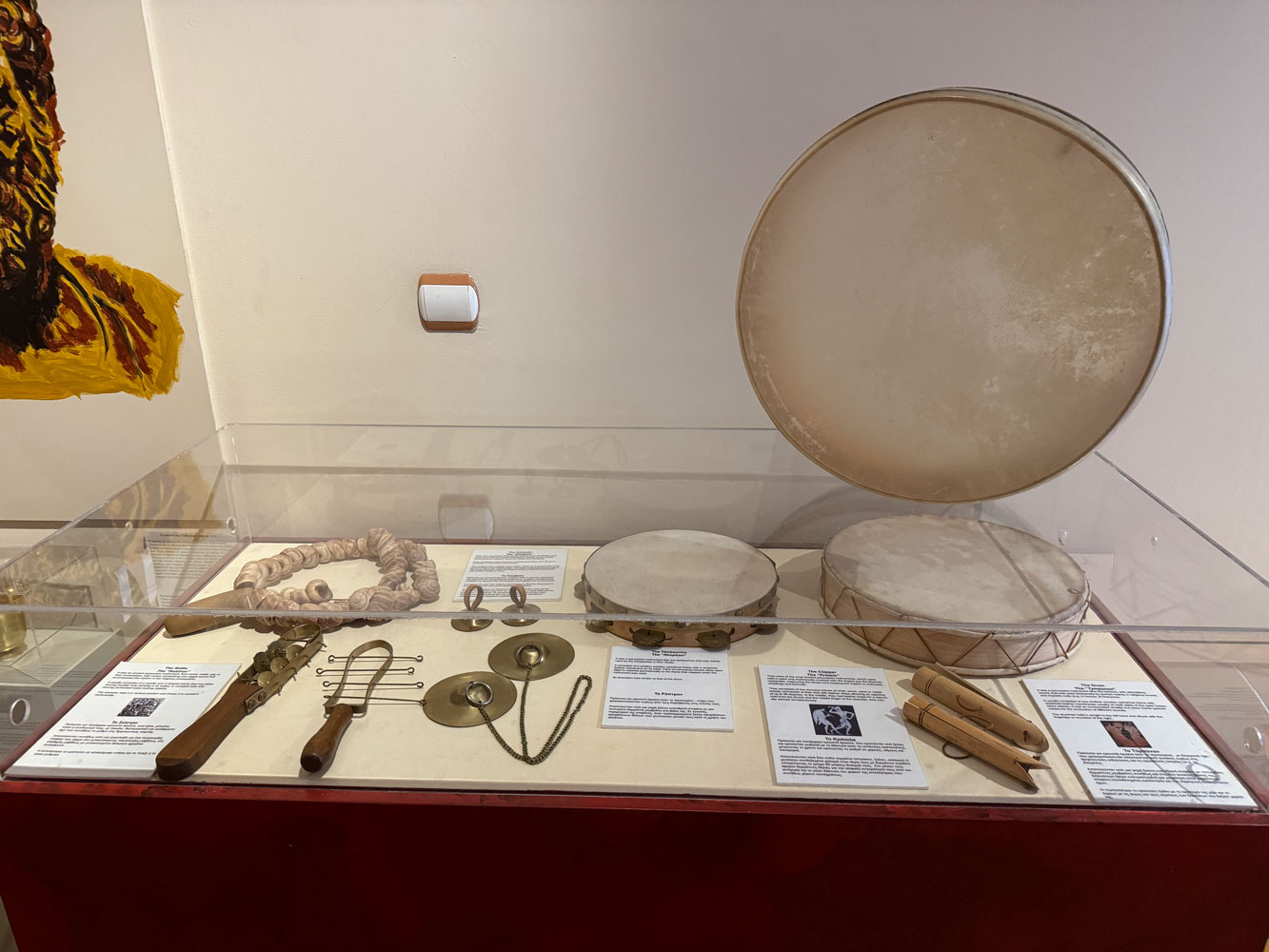
Wind instruments.
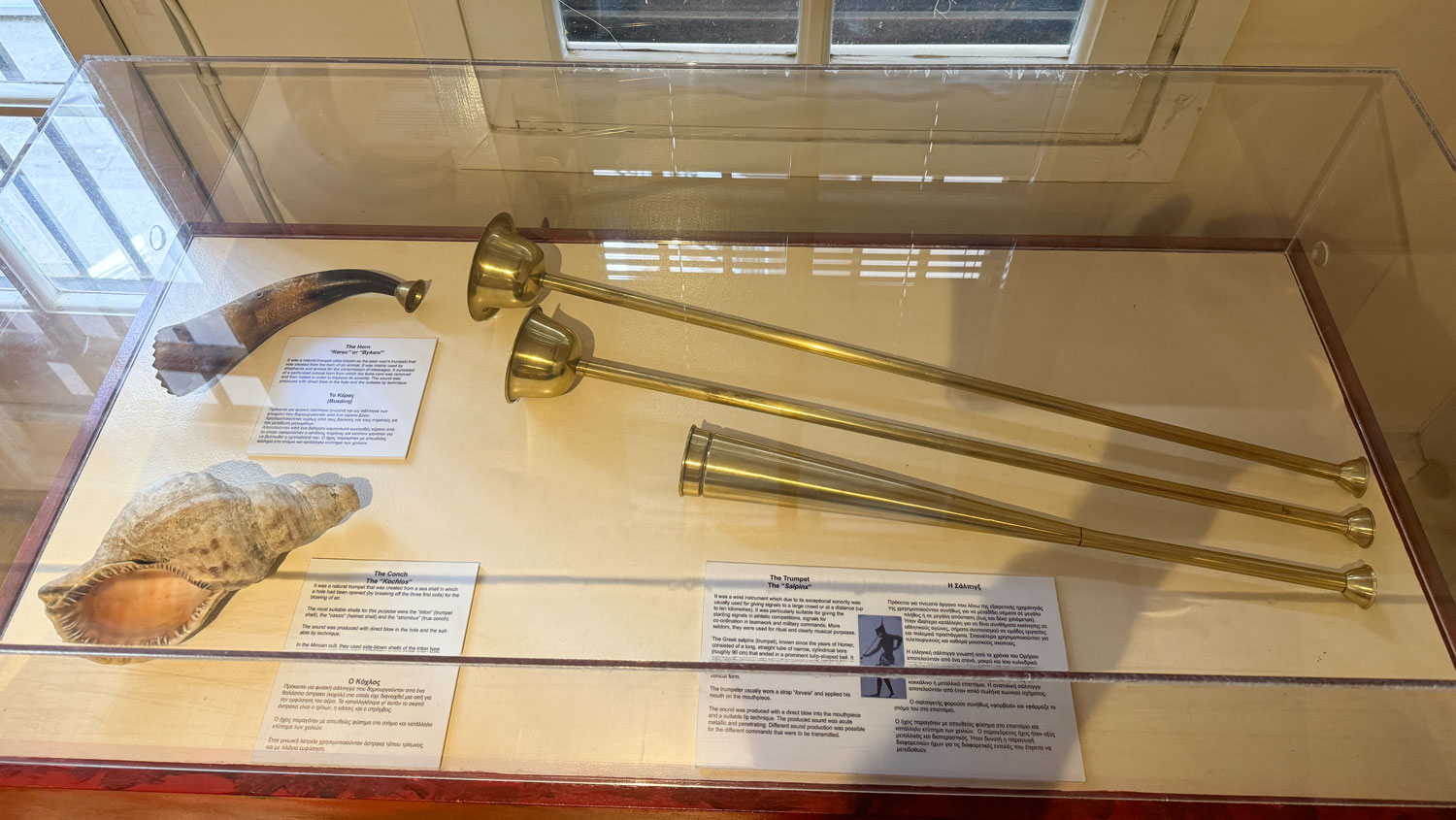
An early bagpipe. I understand that shortly after its introduction, the inventor, along with the inventor of the accordion, were burned at the stake (that's a musical joke).

There was a lot more, but I'll stop here. They had some crossbow devices, but they were not very practical and I doubt if they were ever used in war.
We headed back to the hotel to prepare for the Welcome Reception at 6pm.
When we got to the banquet room Michael had a telecoil for me to try with the VOX device. Apparently, he got some information from Tauck about where they were. Now, to see if they will work with my hearing aids, and for that I have to connect them to the VOX unit and someone has to be transmitting.
Here's Michael addressing the group about the upcoming tour and cruise. I think there are 40 guests.
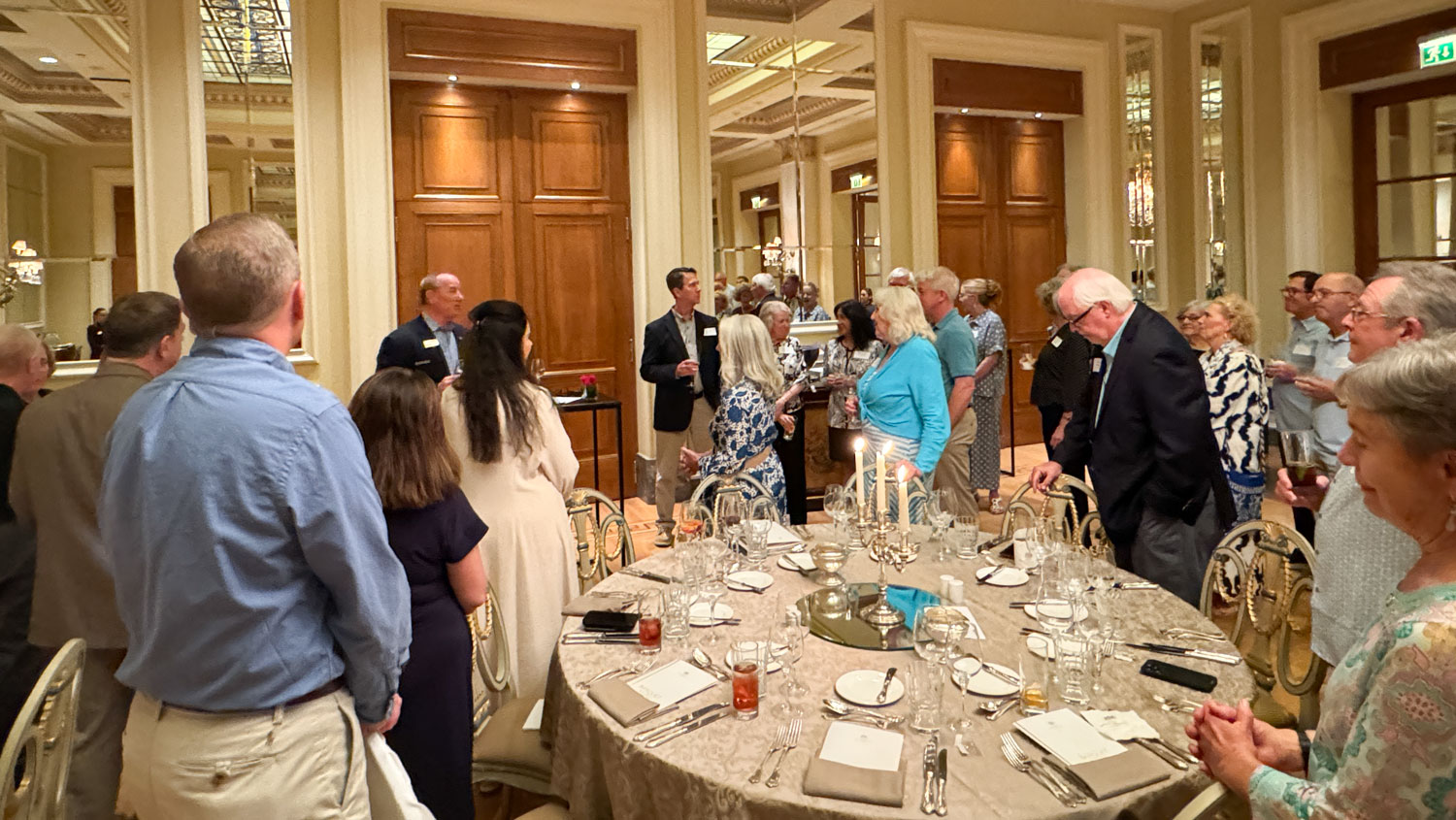
And the group at dinner.
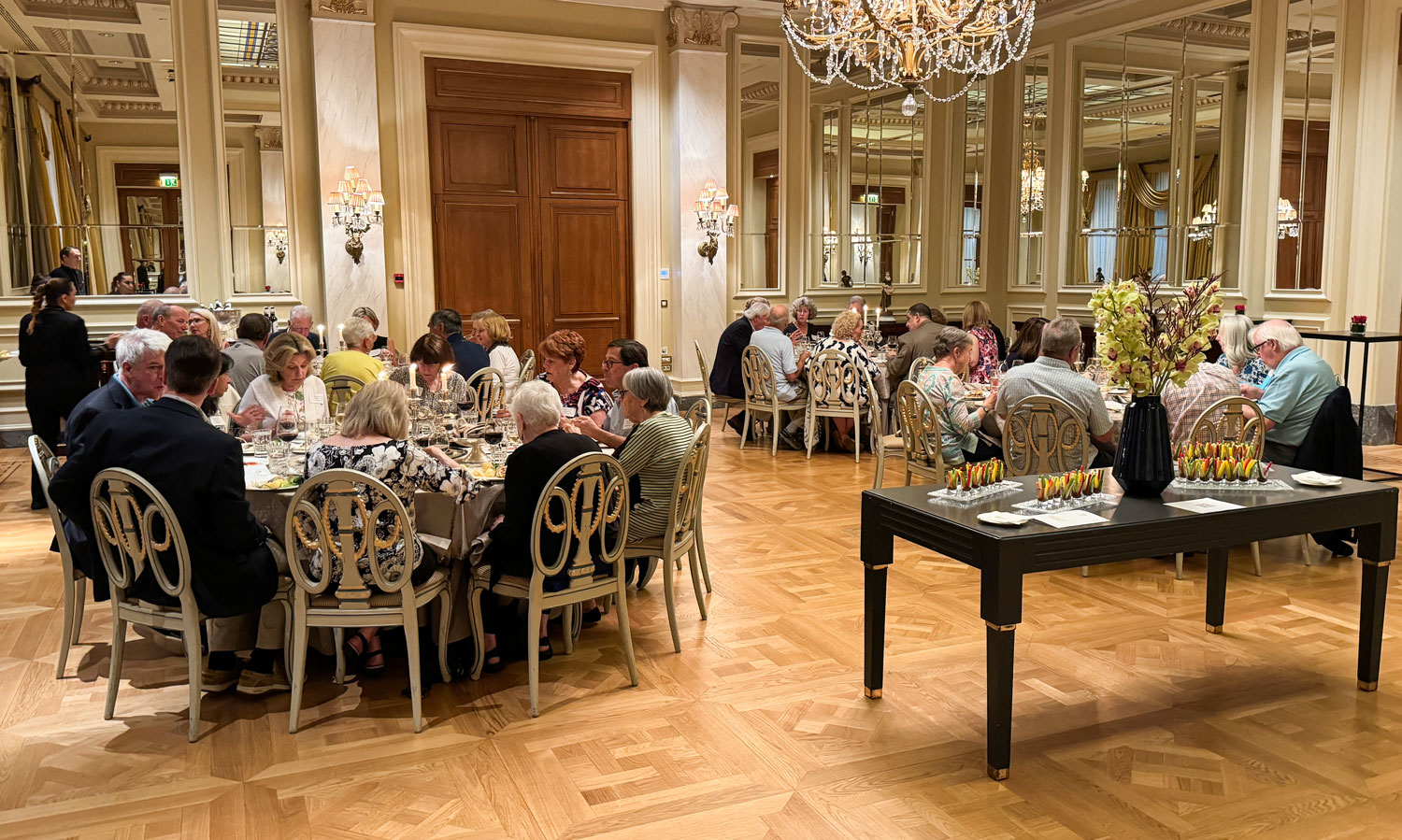
After dinner Judy and I headed back to our room and to bed.
++++++++++++++++++++++++++++++++++++++++++++++++
May 3, 2024 (Friday) We go up to the Acropolis today. The Acropolis is closed in the morning in observance of Good Friday, so we won't leave the hotel until 11:30, arriving at the base of the Acropolis about noon.
We met in the lobby about 11:15 and boarded the bus at 11:30.
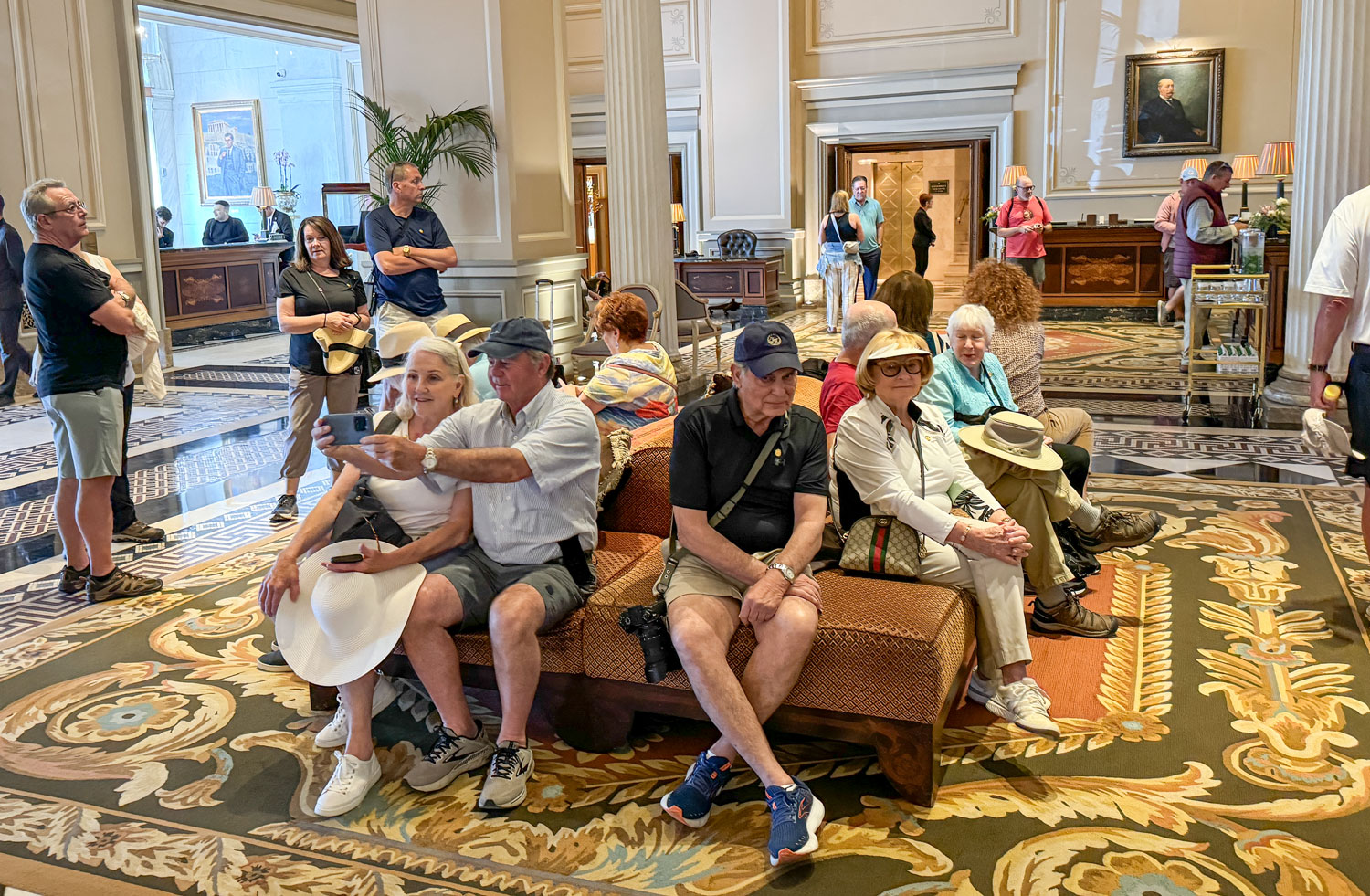
The bus took us to Hadrian's Gate, which was less than a kilometer from the hotel. I tested the telecoil with the guide, but it didn't work with my hearing aids. VOX needs to have a way of using Bluetooth to communicate from the VOX to a smartphone. The smartphone already communicates with my hearing aids.
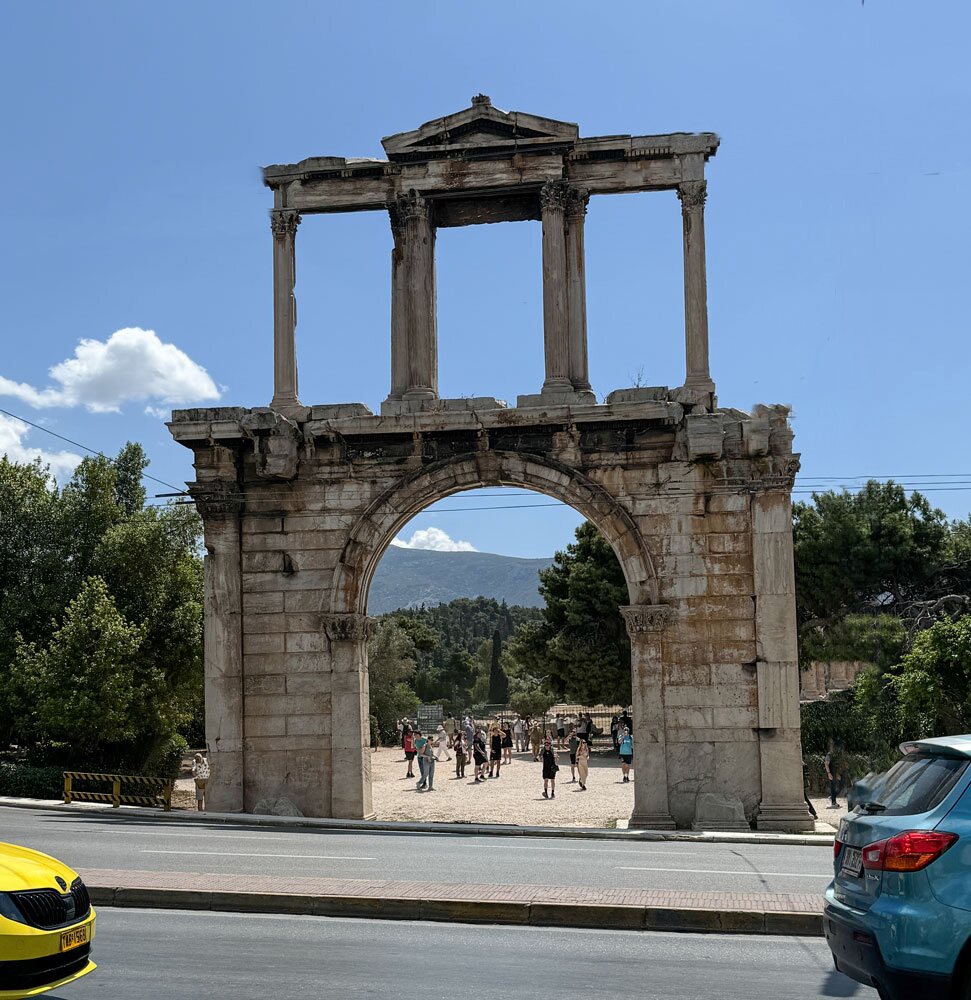
The Acropolis is only a half km from Hadrian's Gate. But the path winds around, so the walking distance is a good bit longer.
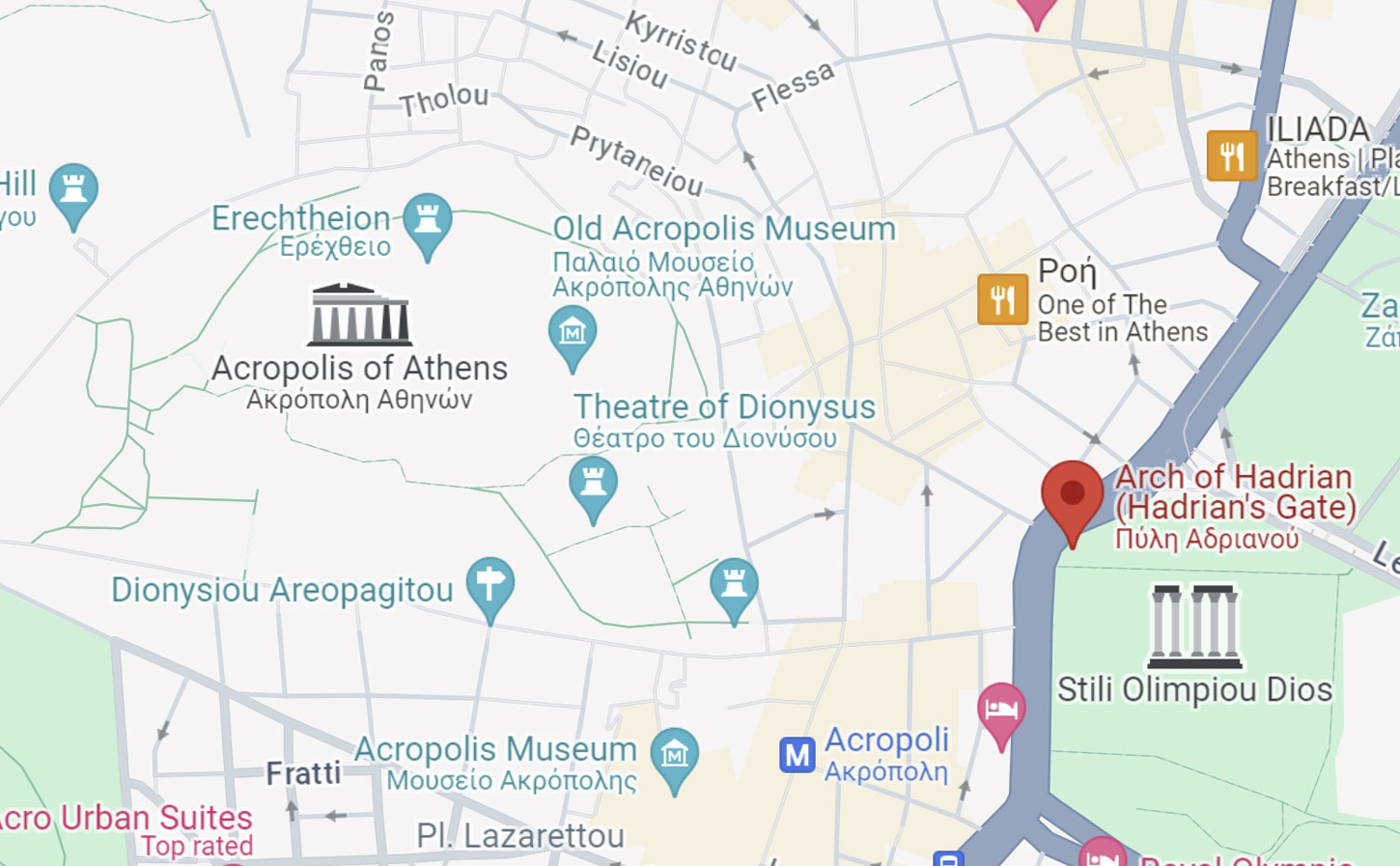
We're heading first to the Acropolis Museum, and it was crazy crowded. Every other tour group in the city was heading to the Acropolis, each trying to get first in line.
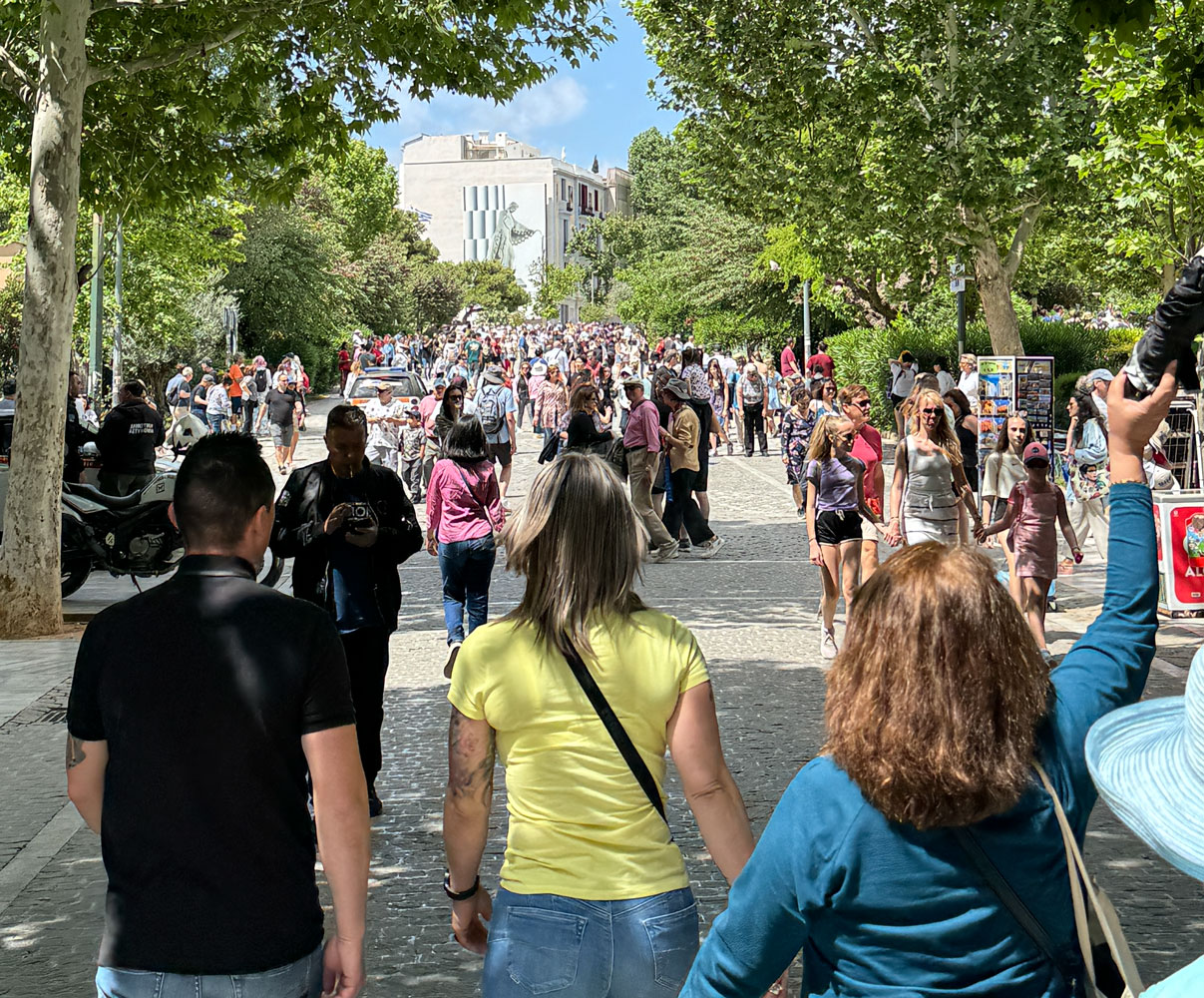
This is the line of people waiting to get into the museum. We had "Skip the Line" tickets, but apparently so did everyone else.
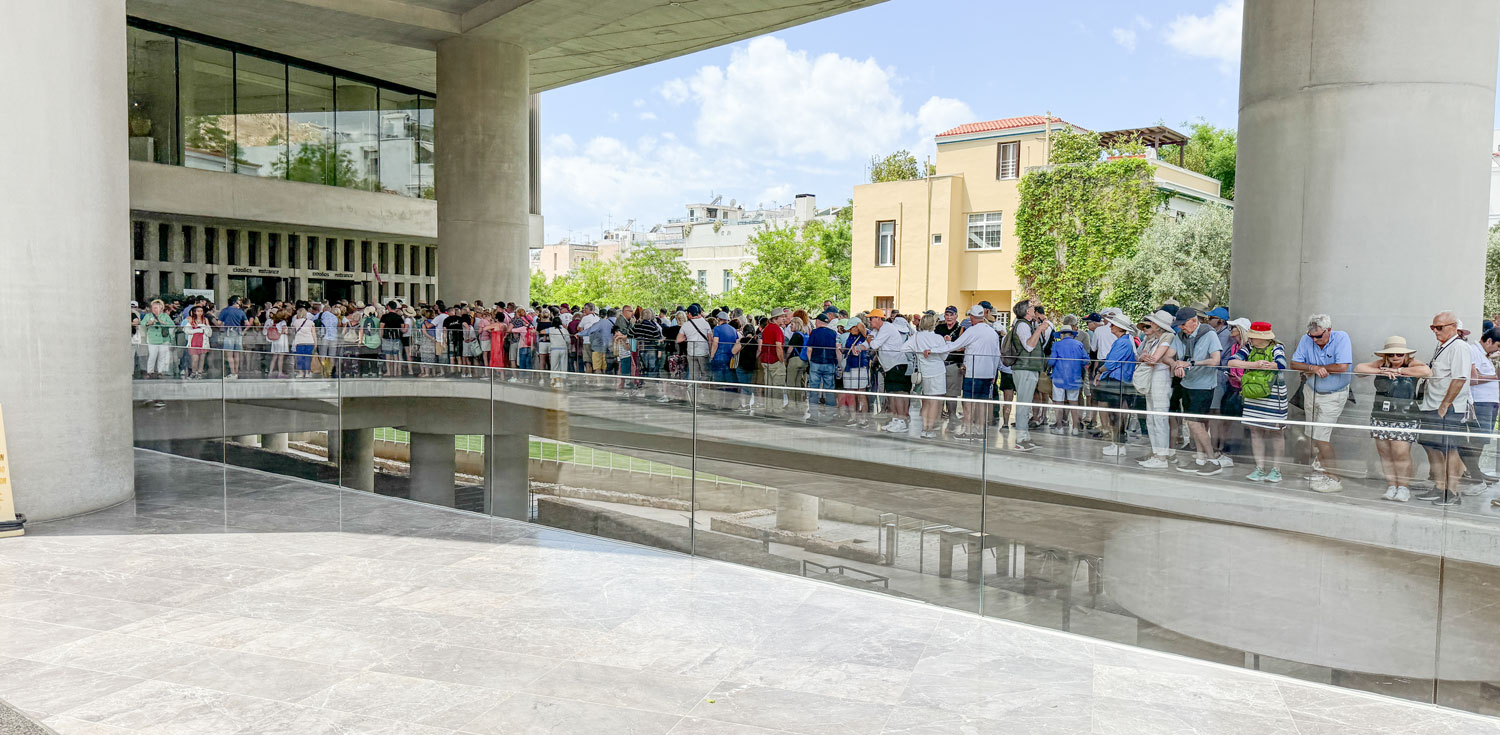
We did finally make our way to the entrance.
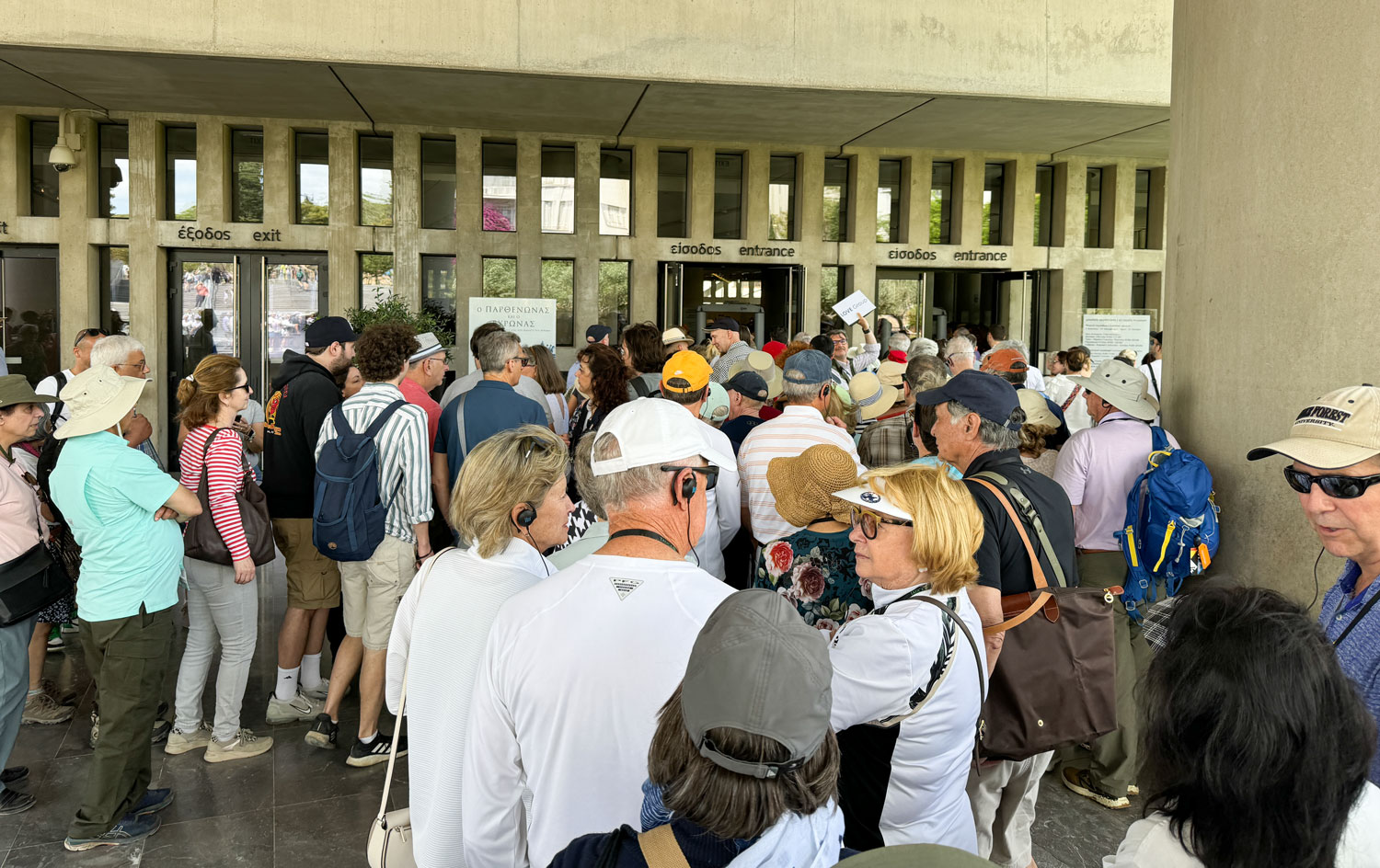
I didn't take many pictures in the museum. Here's a reconstruction of the figures which were originally on one end of the Parthenon.
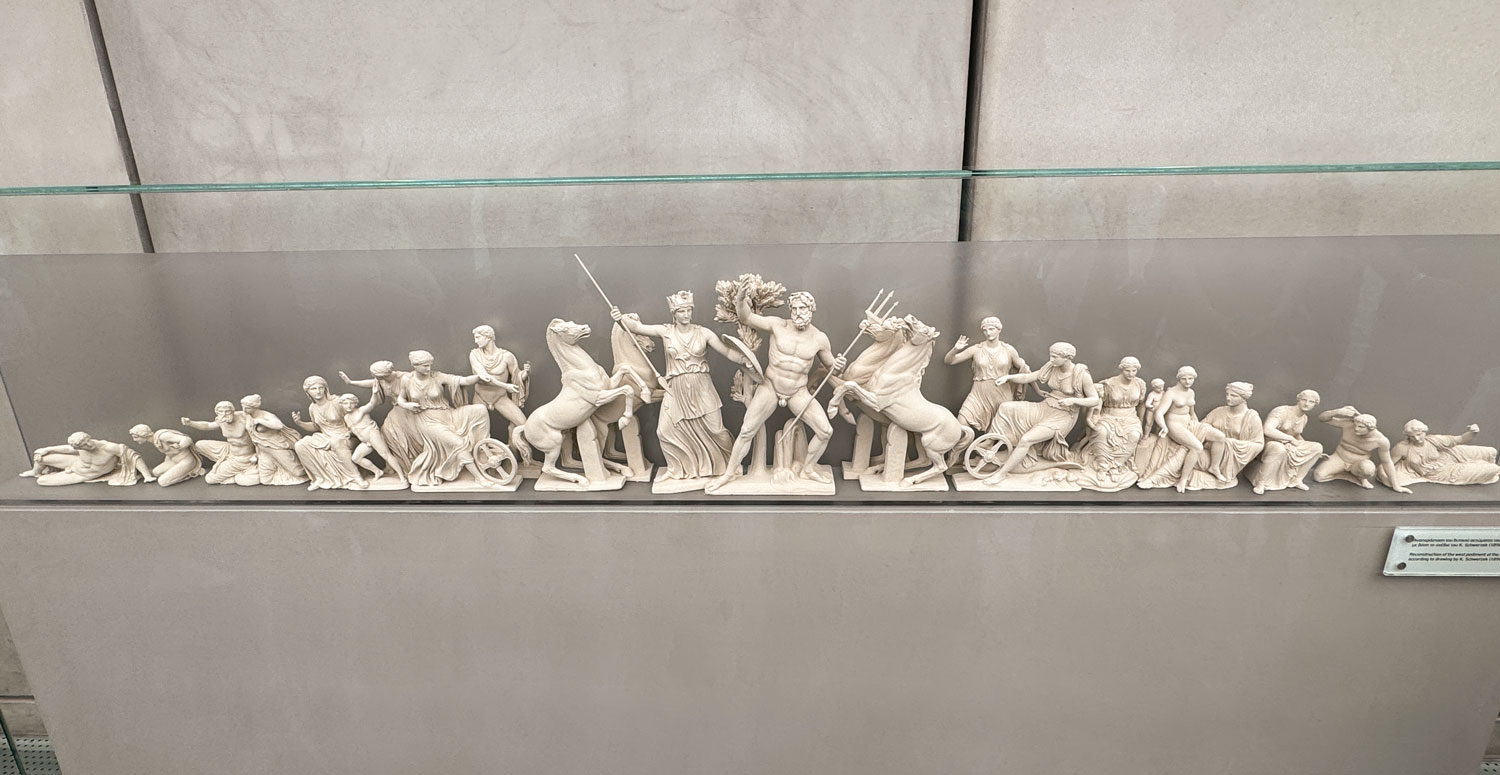
Part of a frieze that was along the side of the Parthenon.

There was a lot to see, and we went through the museum for a couple of hours. At 2pm, we went to the coffee shop and Tauck bought each of us a drink of our choice (Judy and I had coffee).
We were sitting at a table with two other couples, and had a nice conversation about travel. Here are Charles and Anita.
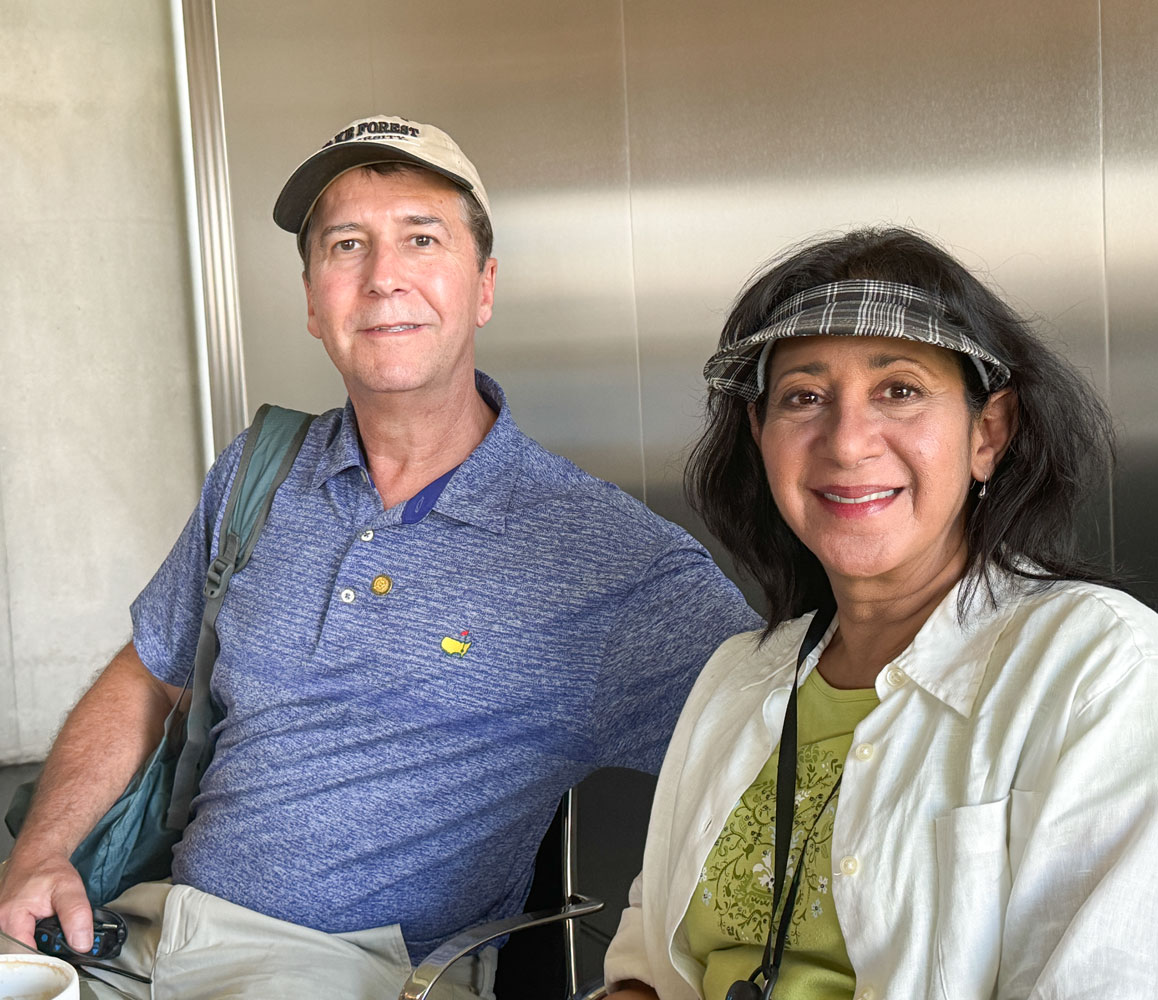
And Kathy and Bill.

When we left the museum we began walking along a pedestrian path towards the Acropolis. From the path, we could see the Parthenon.
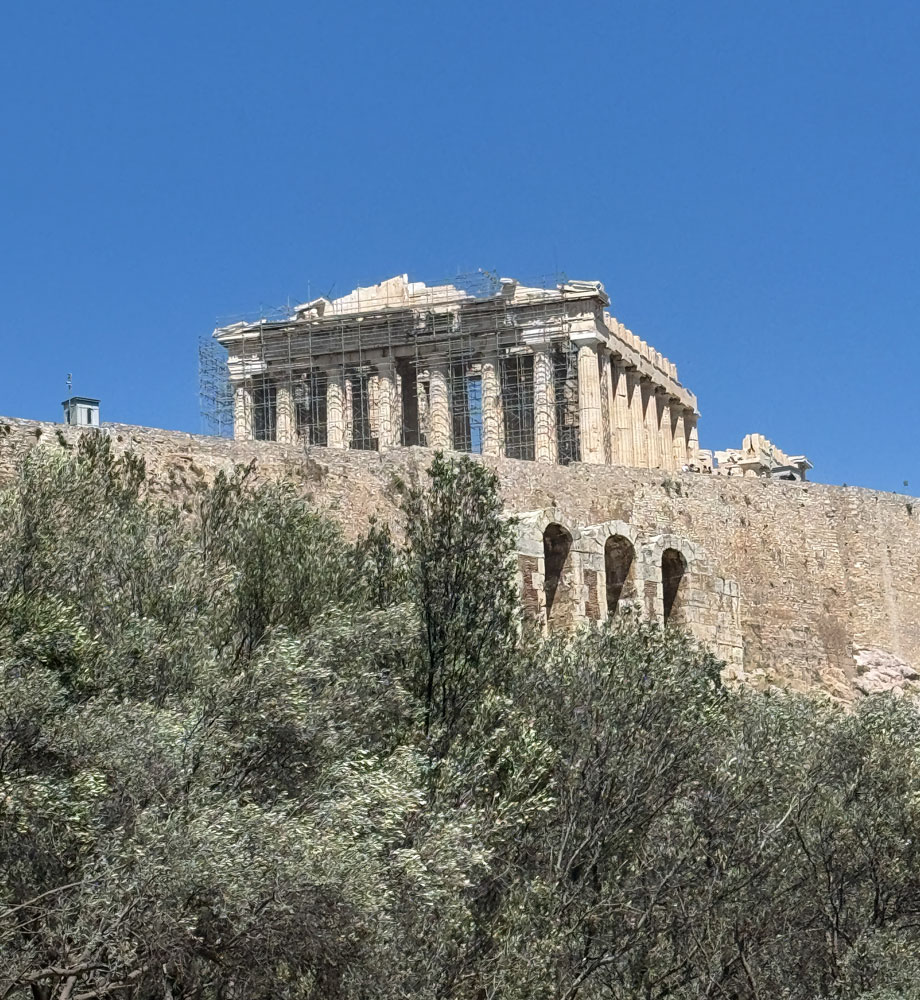
The path led upwards but it was not that difficult. Eventually, we reached the entrance and presented our tickets. The path became a bit steeper, but it was not a problem. The temperature was comfortable, in the low 70's, but with a brisk wind.
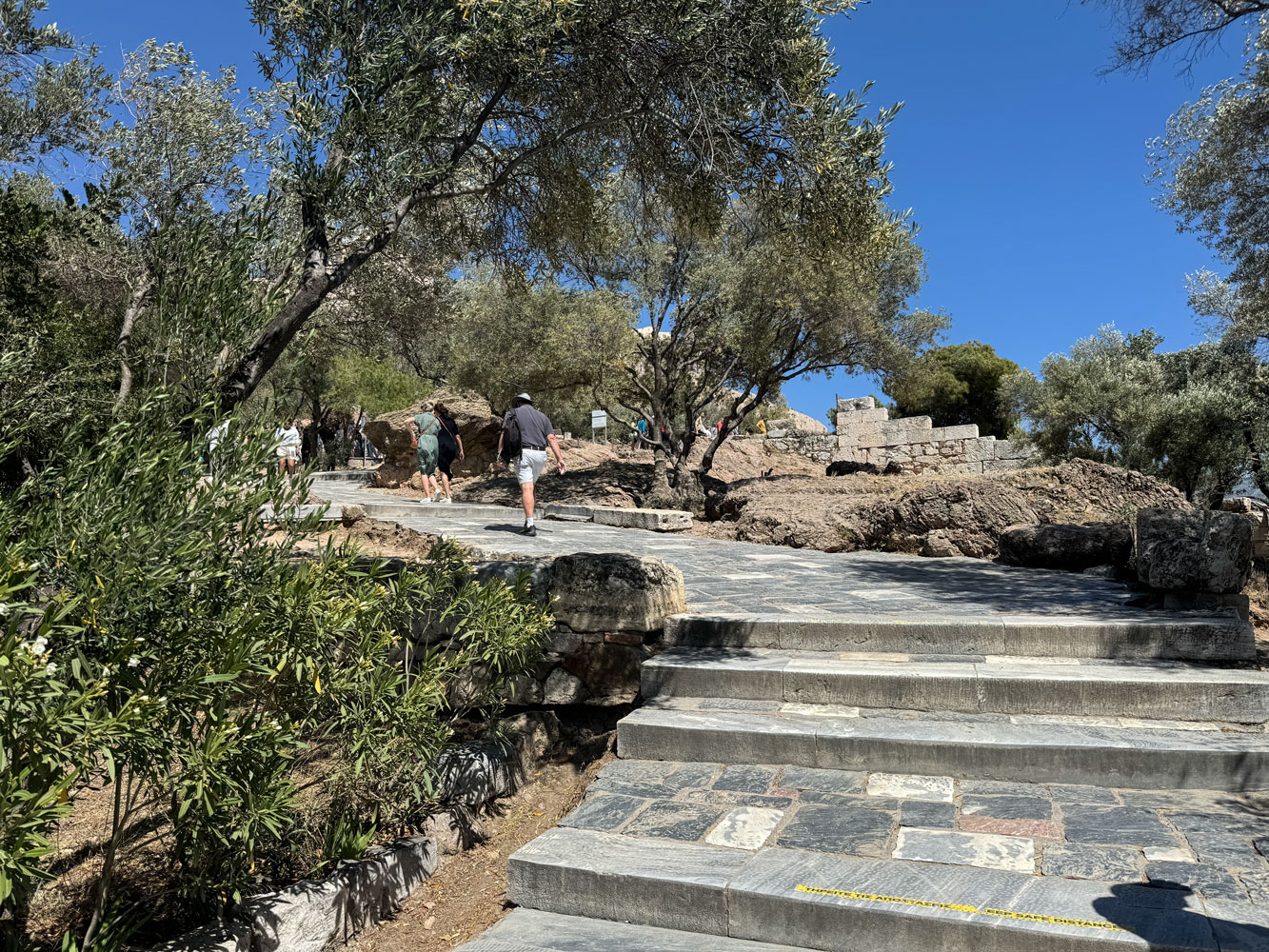
The path led by the Odeon of Herodes Atticus. It's obvious that this theatre has been renovated. It looks like it's currently used for performances. The Theatre of Dionysus is just a bit further along on the hillside of the Acropolis but we did not go by it. The two theatres are connected by the Stoa of Eumenes.
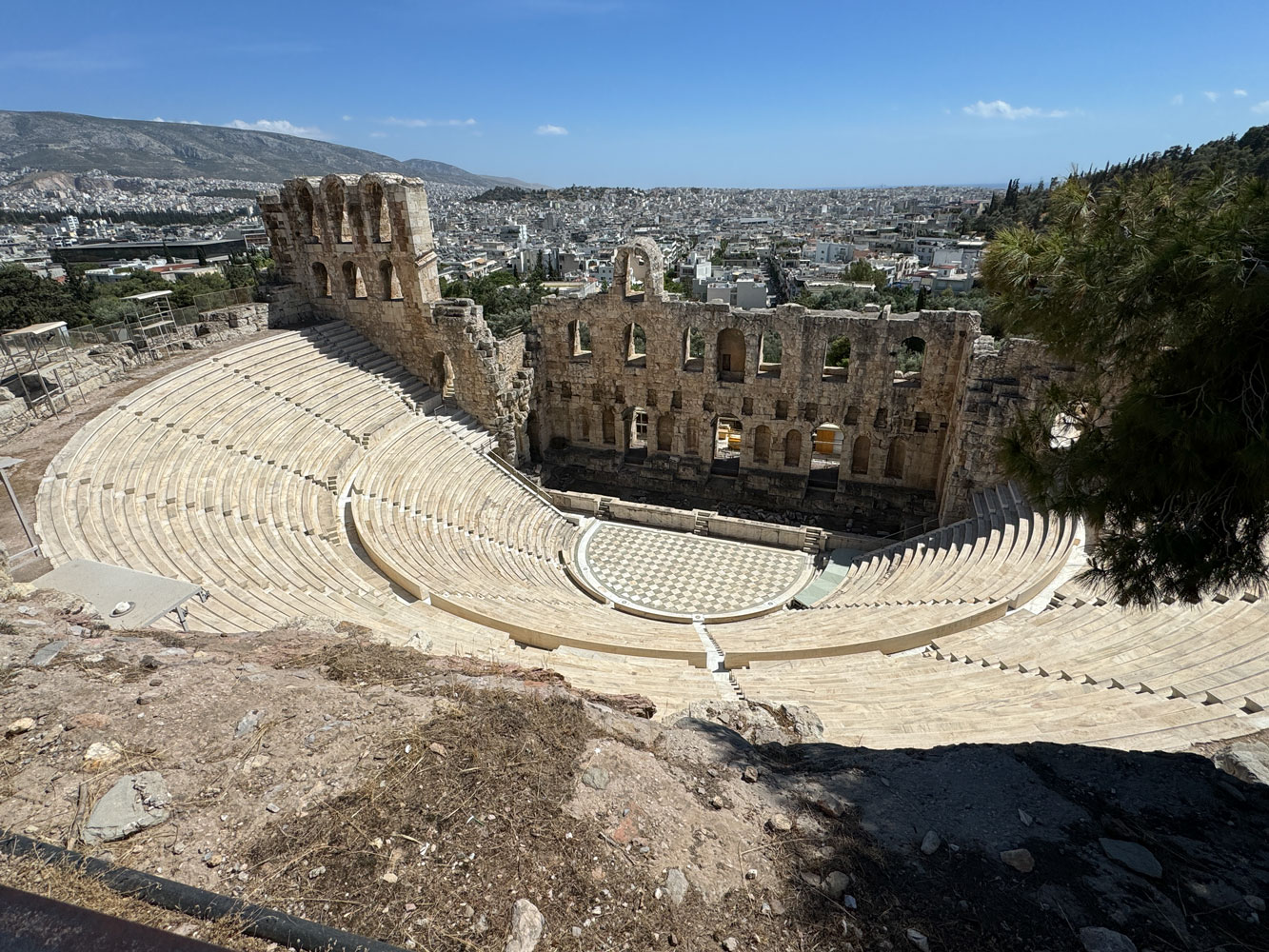
A little further on, the path became very congested. There was also a strong wind blowing from the left in this picture.

Another view of the congestion getting up to the top of the Acropolis. You enter the Acropolis through the Propylaia (what's left of it).
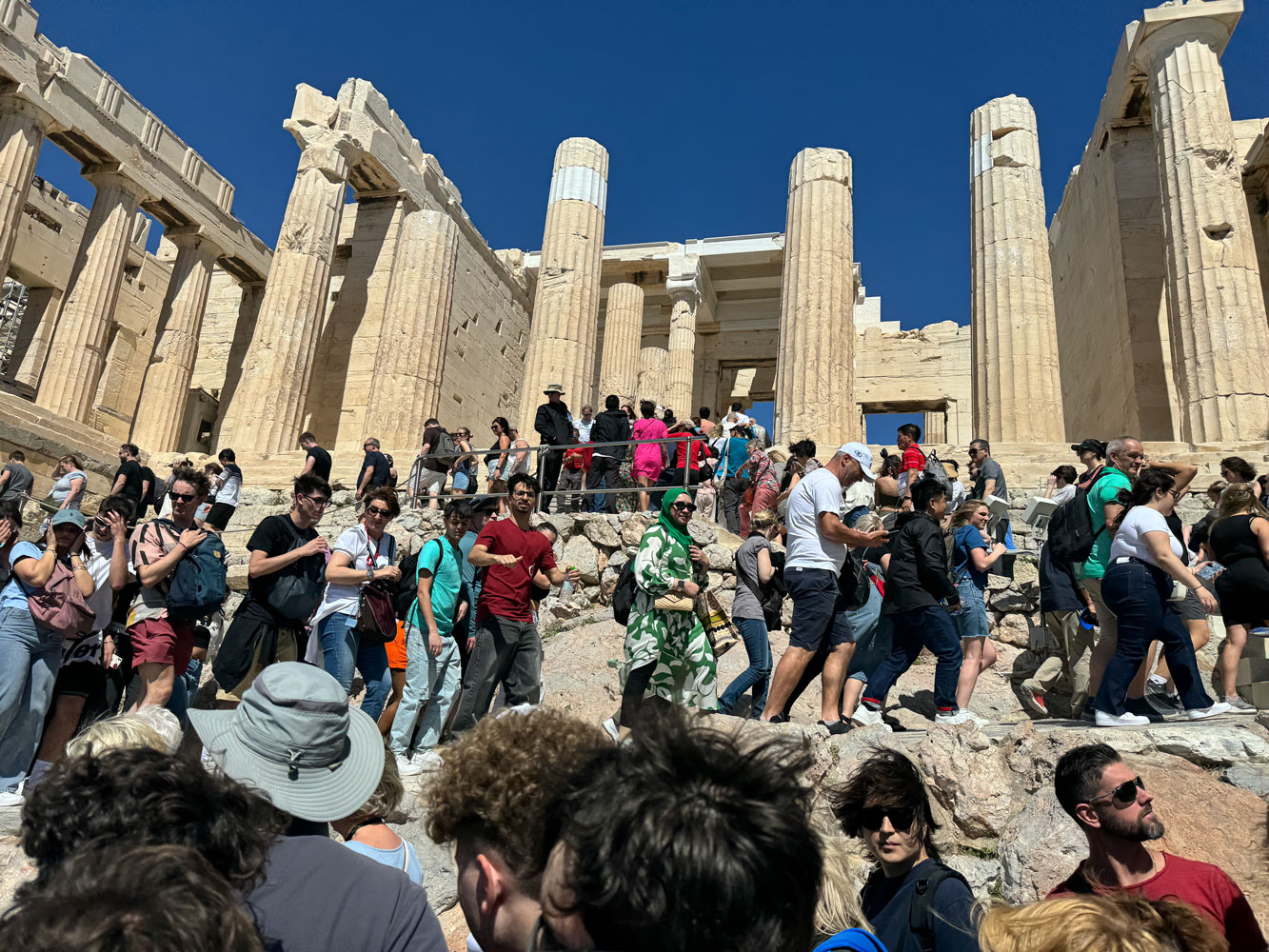
Here's the layout of the Acropolis, just for reference (from Wikipedia). We're entering through the Propylaia, labeled 5.
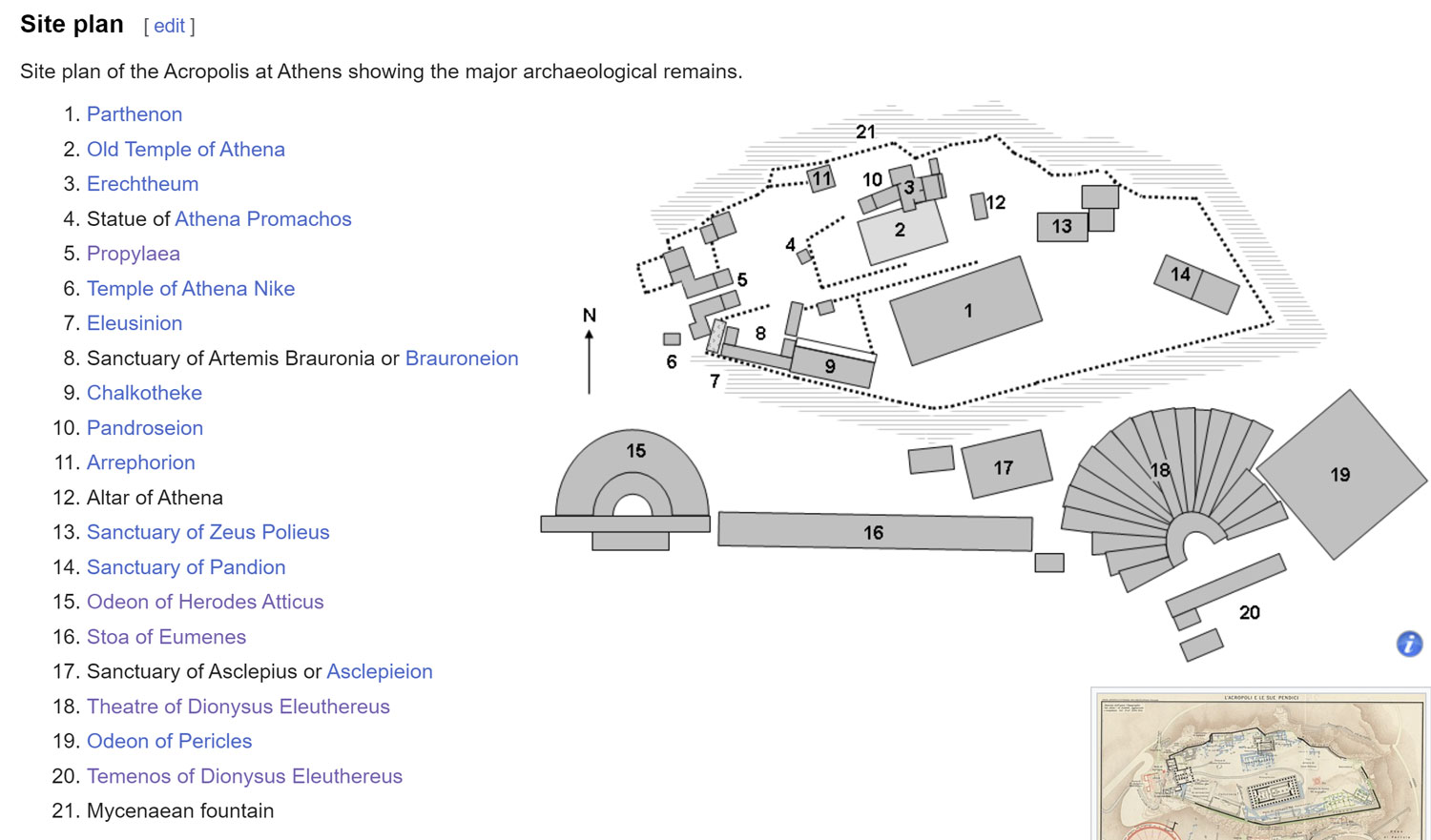
At the top, it was very crowded. That's Michael, our TD, holding the Tauck sign. I have an altitude app on my phone and checked the altitude gain from the museum to the top of the Acropolis - it was about 200 feet. Not that tough a climb. The top of the Acropolis is 500 feet above sea level.
Google says that the path from the museum to the top of the Acropolis is 800 meters. So 200 feet of rise, over 800 meters of distance. 800 meters is about a half mile. Michael, in describing the walk to the Acropolis, made it sound much tougher. I suppose they'd rather not make it look like a "cake walk" and then have someone not be able to make it.
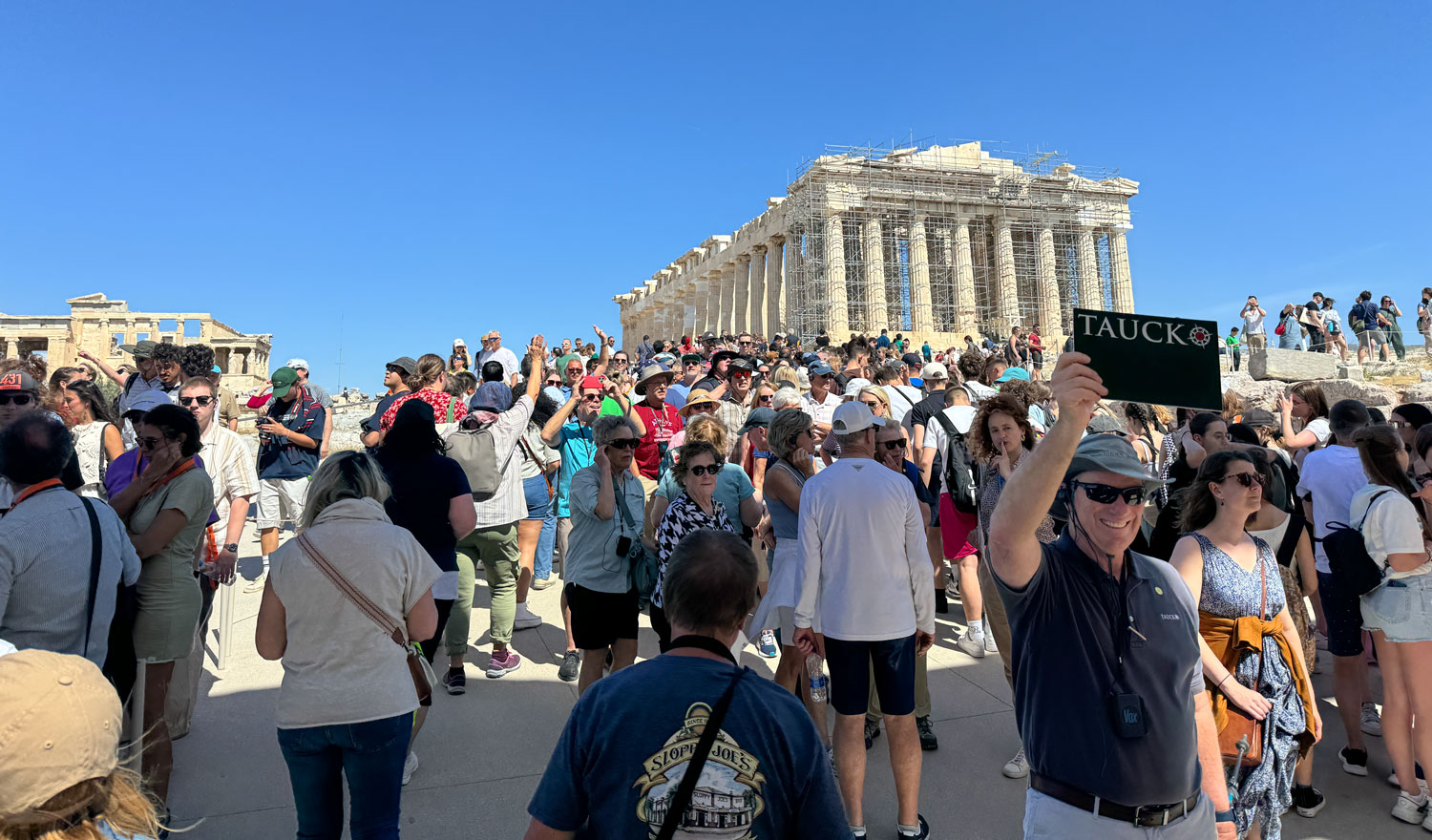
The entrance side of the Parthenon. That doesn't mean we could enter the Parthenon - it means that when it was a temple, people entered from this side.

Here's Judy and me with the Erechtheion in the background.
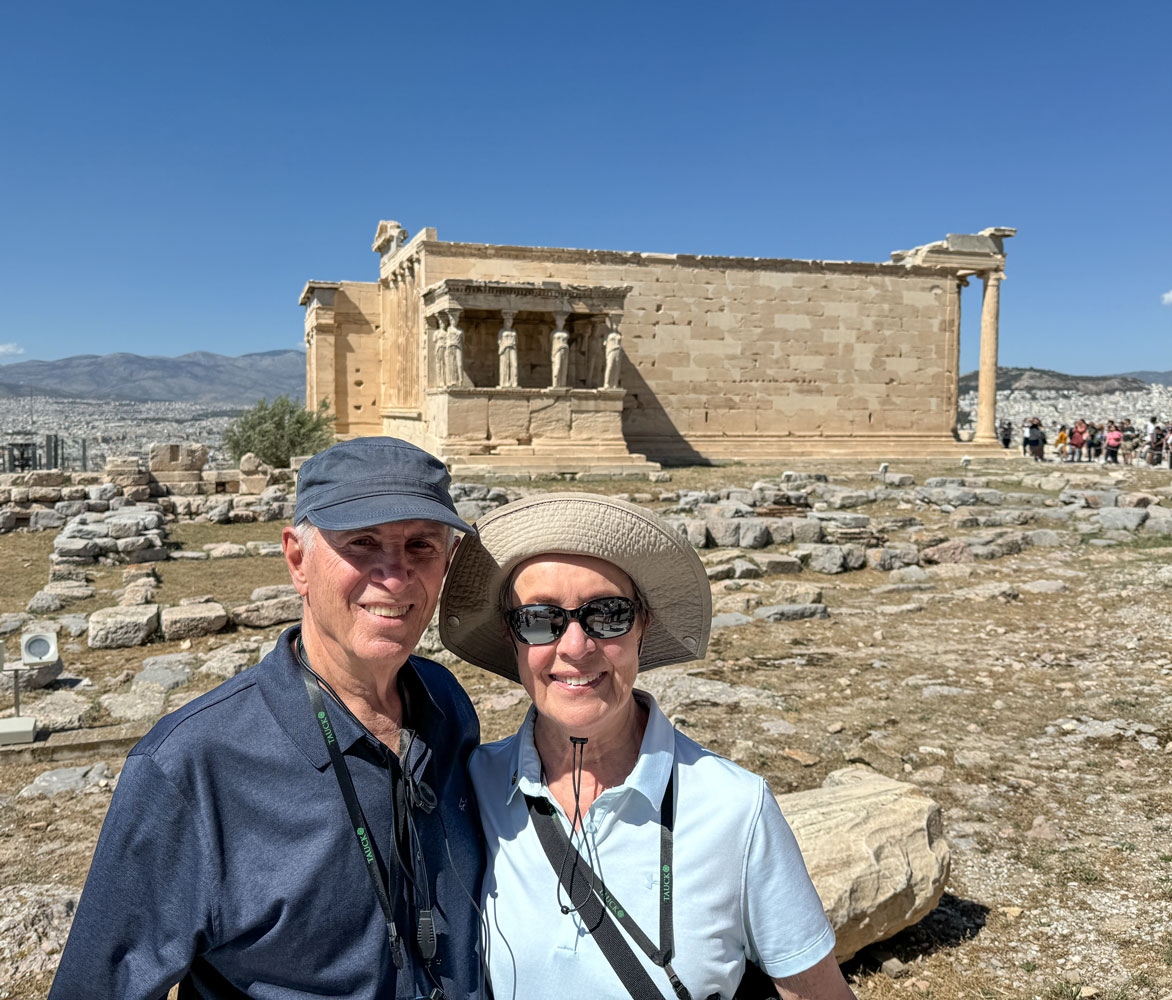
A view of the "back" of the Parthenon. There's not a lot left of the Parthenon.

I went down to the back of the Erechtheion. There's not a whole lot of it left, either.
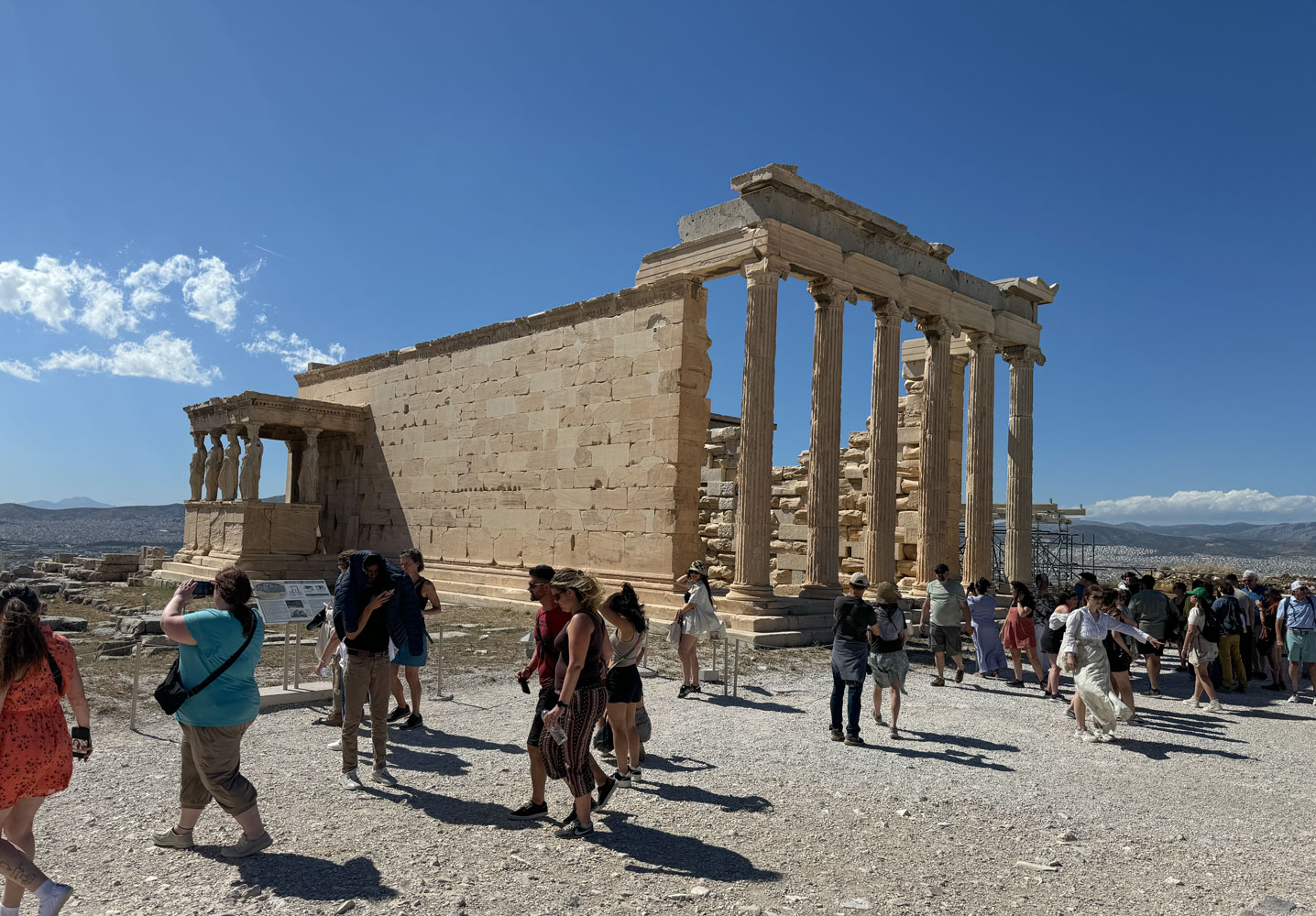
The other side, the front, of the Erechtheion

As we were leaving the Acropolis, I walked over to where I had a "head-on" photographic shot of the Parthenon. They should rebuild the Parthenon to the way it was in antiquity. If Notre-Dame in Paris can be rebuilt, the Parthenon could be.
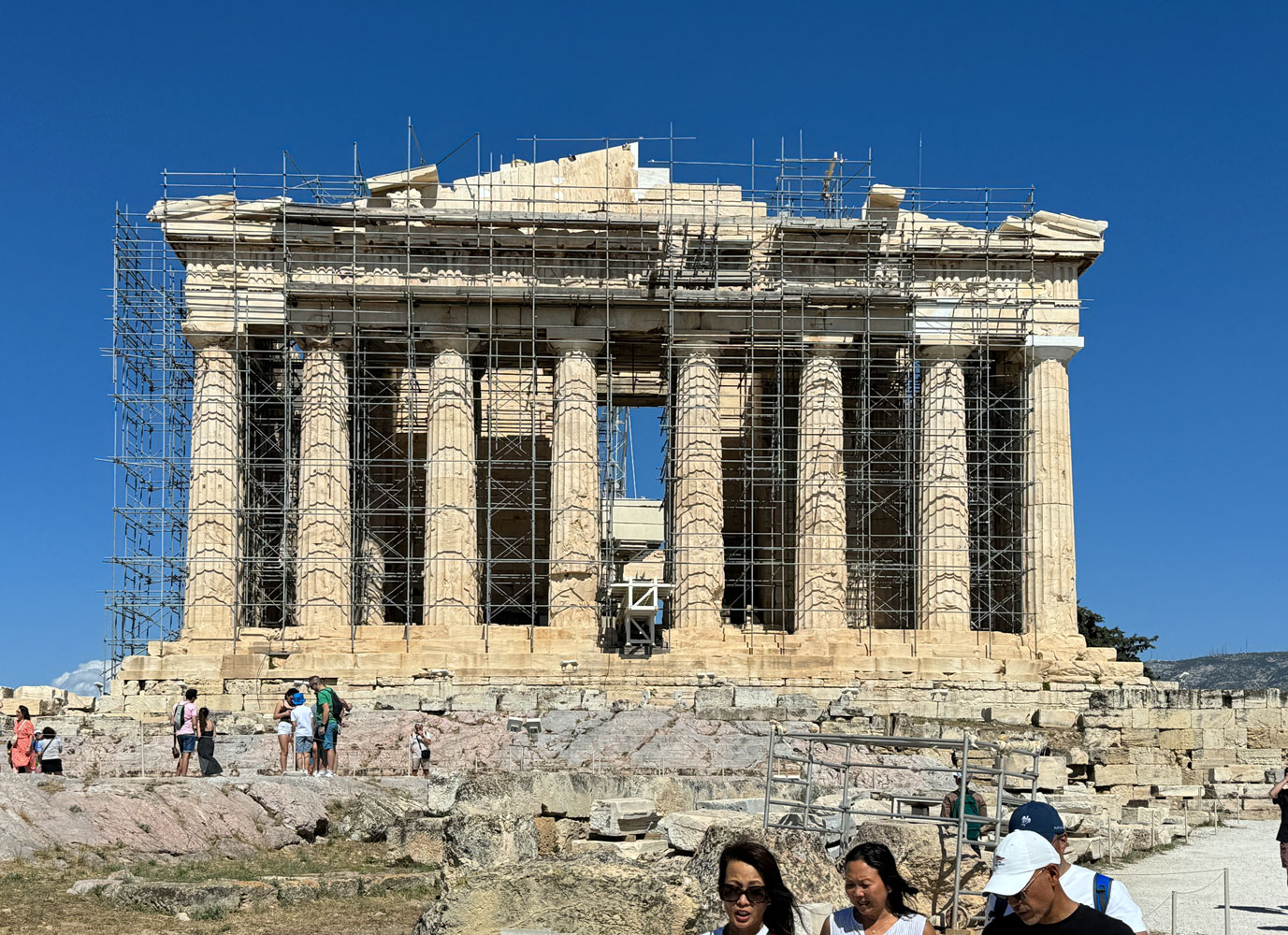
Update 6/17/2024: I just found that the Parthenon has been reconstructed - in Nashville! It was completed in 1897 and is an exact reproduction of the Parthenon in Athens.
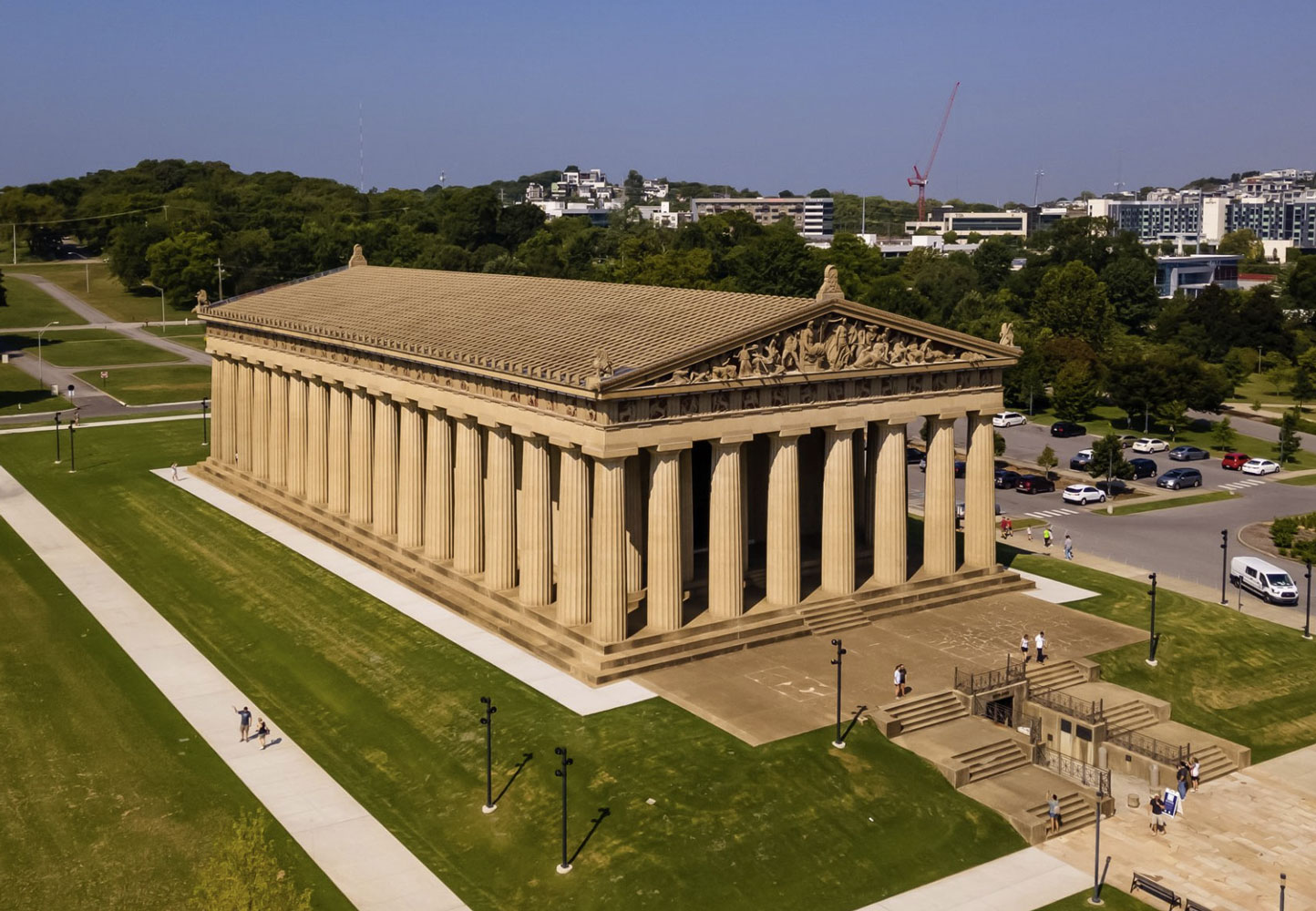
Here's another located in Donaustauf, Germany, called the Walhalla.
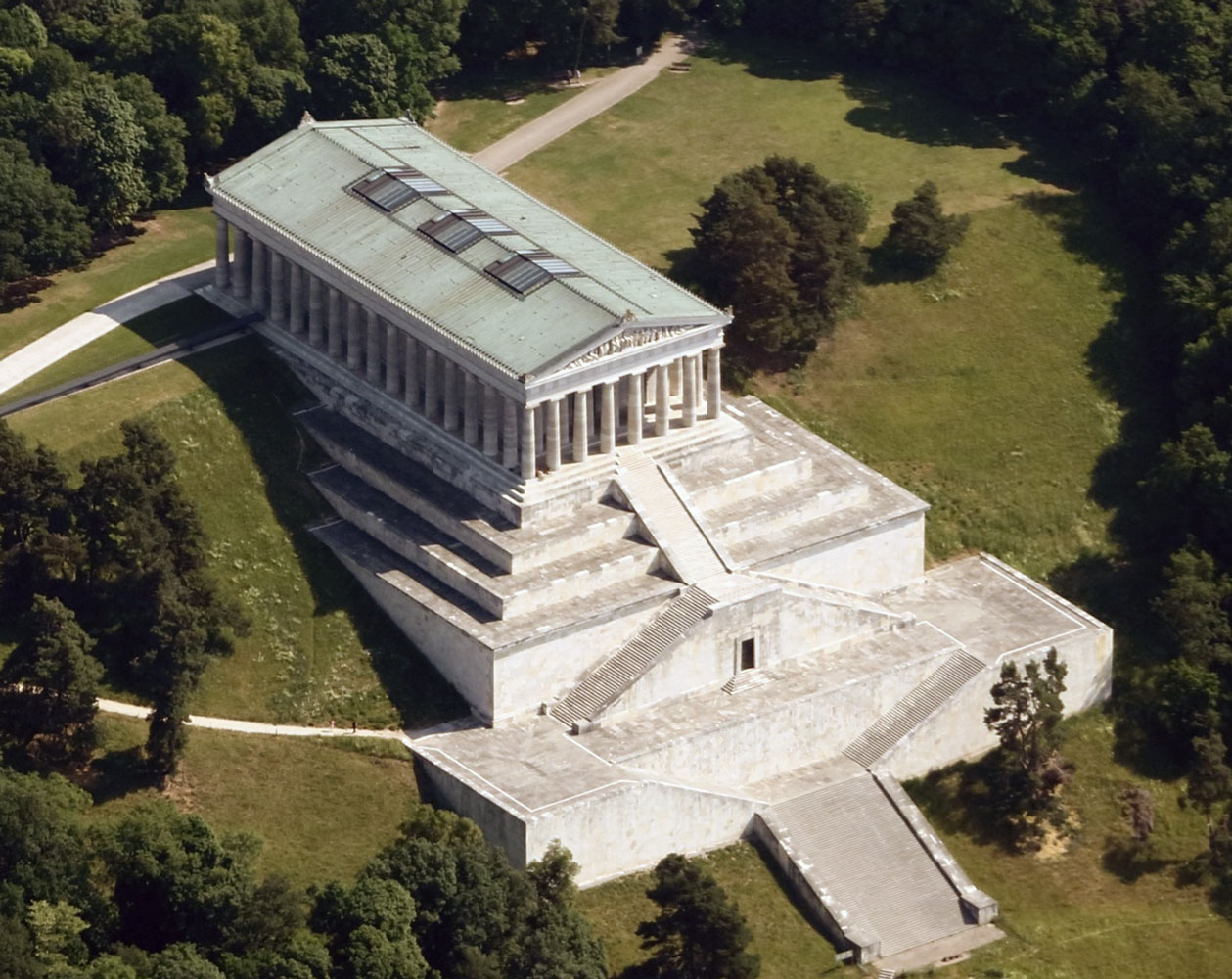
End of update.
About 4pm we made our way down to the entrance area and waited for Michael. As we were leaving, I took this picture of people still arriving. Perhaps it was the holiday (Good Friday) but there were a LOT of people going to the Acropolis.
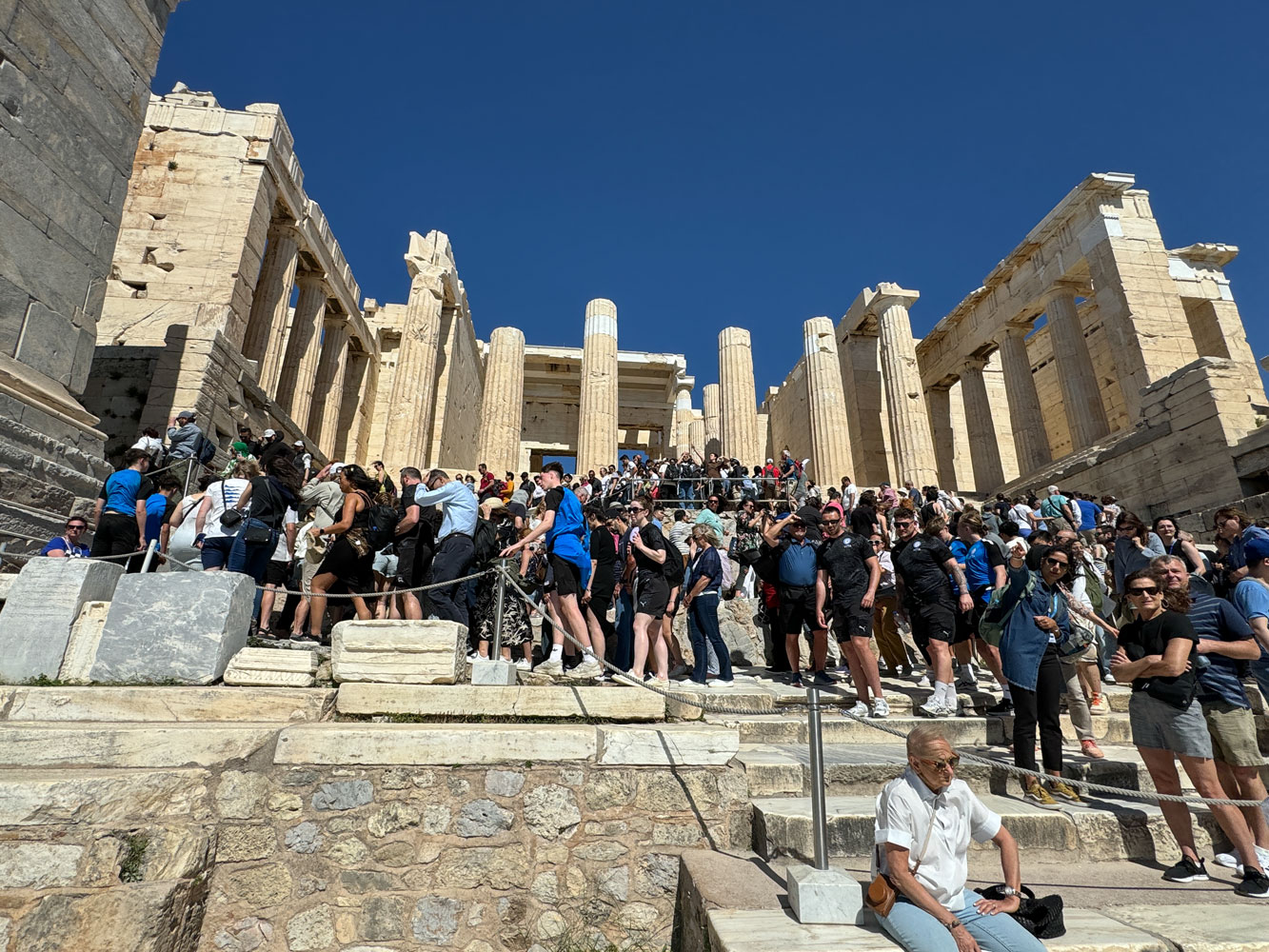
I'm glad we saw it, but it's not something I need to repeat.
When we reached the base of the Acropolis, we were offered two options for returning to the hotel: (1) take the bus back, or (2) walk down with Michael. We decided to walk down, and it was not a difficult walk.
On the walk down, we came to the Church of the Metamorphosis.
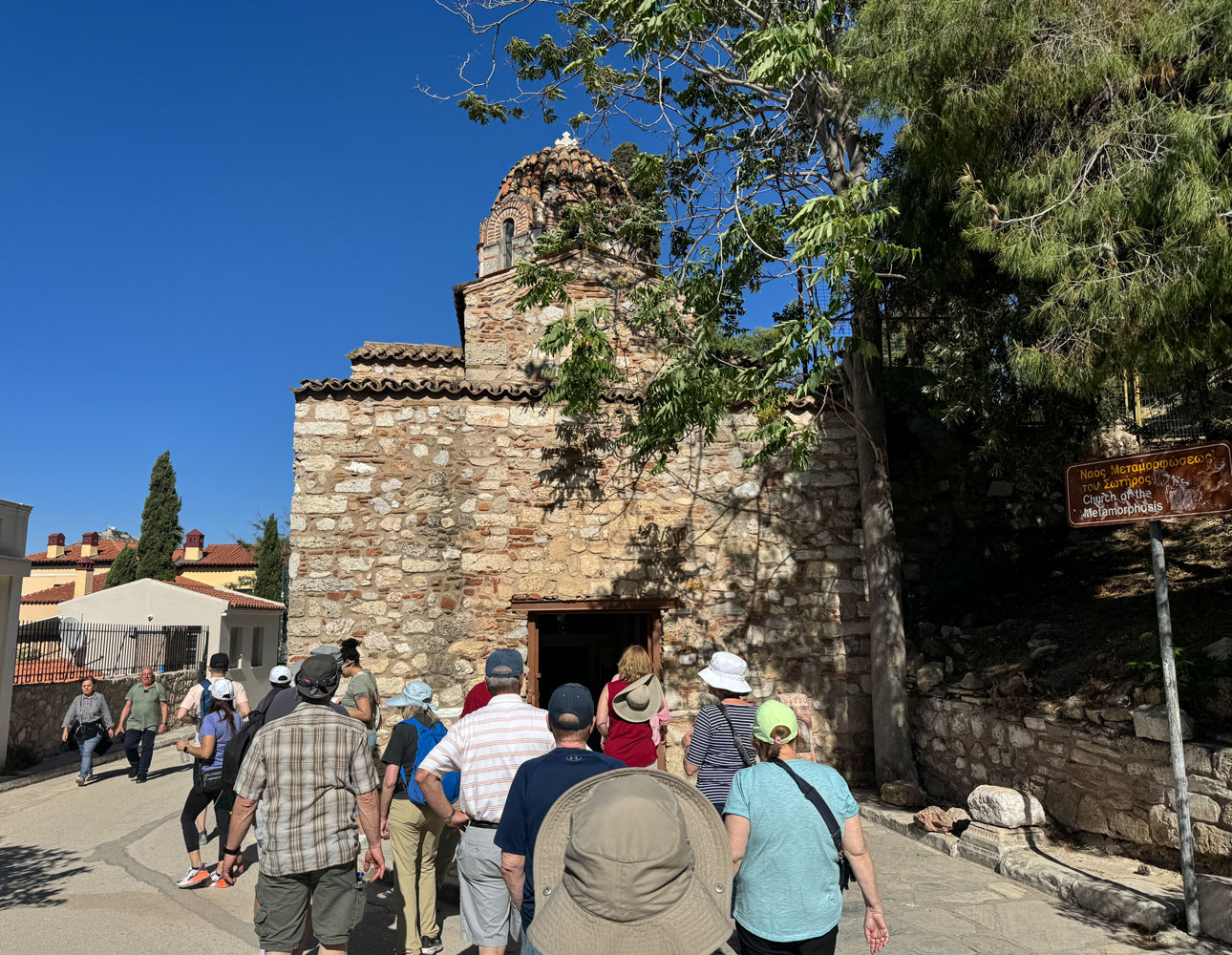
It appears that there are a number of these small churches in Athens. I wonder how they are supported financially. We saw the same thing in some Muslim countries where there were many small mosques. [Update: I asked a local tour guide and she said that each neighborhood had its own church, and the people of the area support it financially.]
We came to a small alleyway that led to the Plaka steps. Michael was familiar with this route, which led down into the main part of Athens, and we took it.
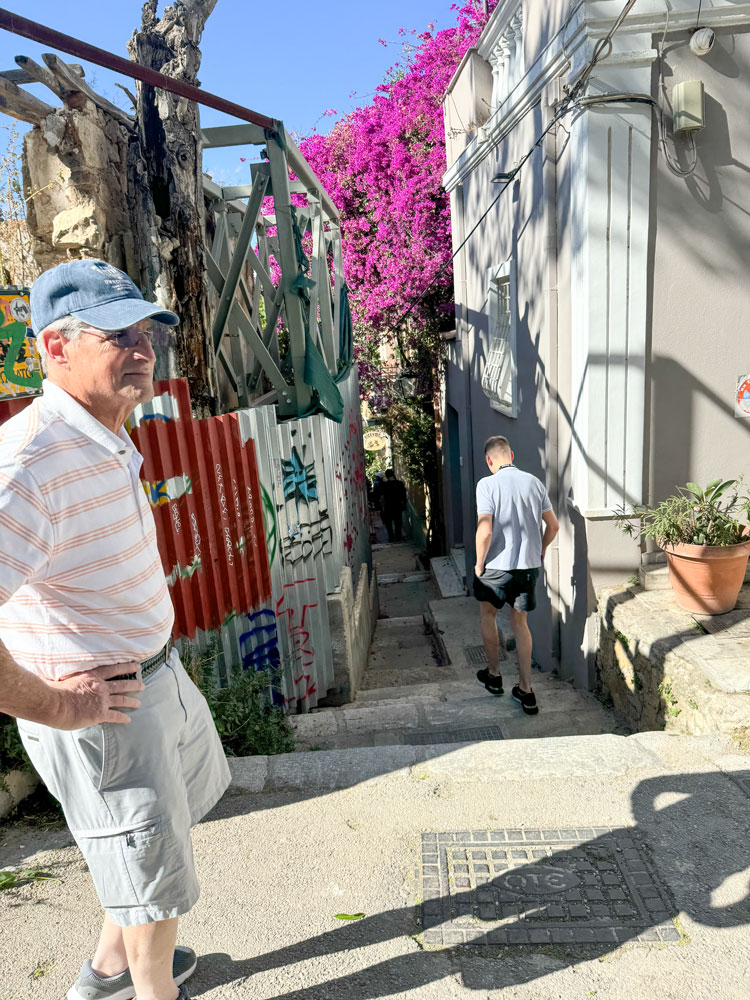
There were quite a few steps, but it was not a difficult walk. There were a number of restaurants on either side.
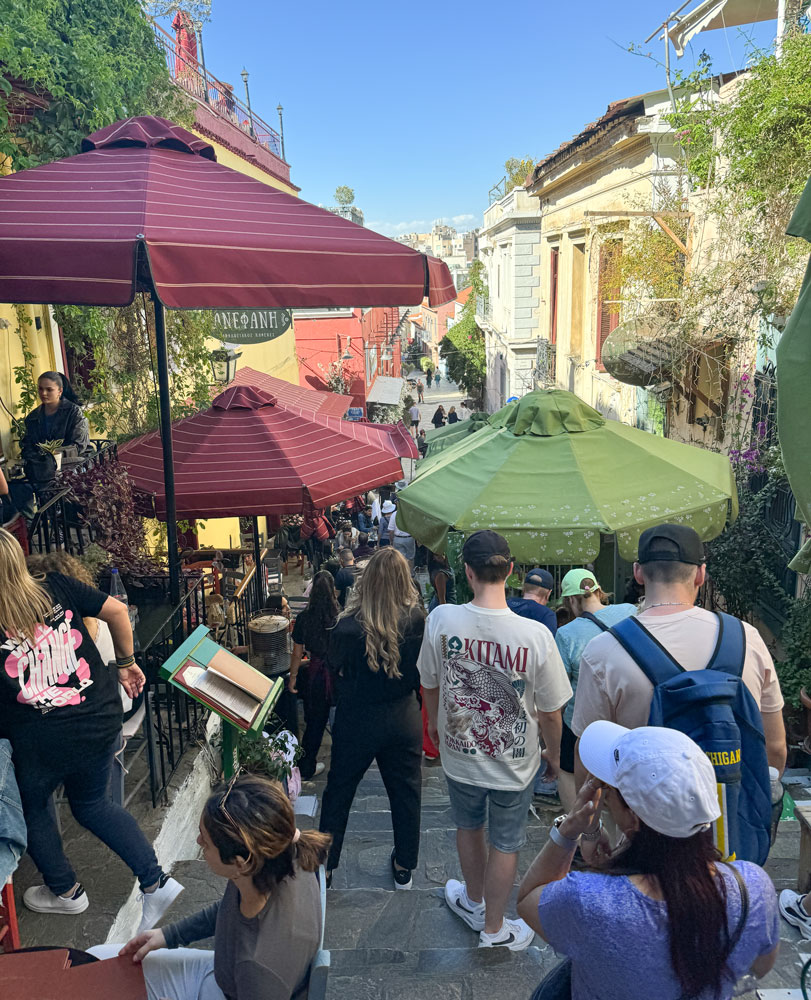
Here's a view looking up that alleyway.
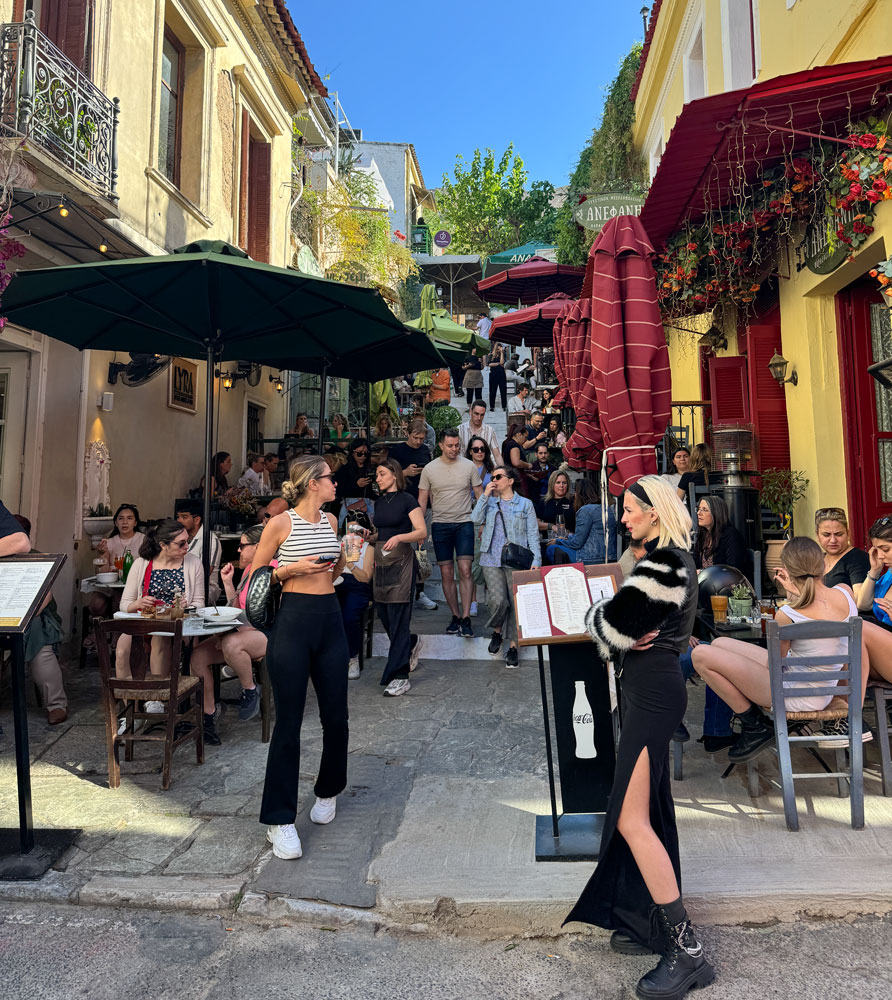
A short walk from here brought us to the Metropolitan Church, and this time we went in to see the interior.
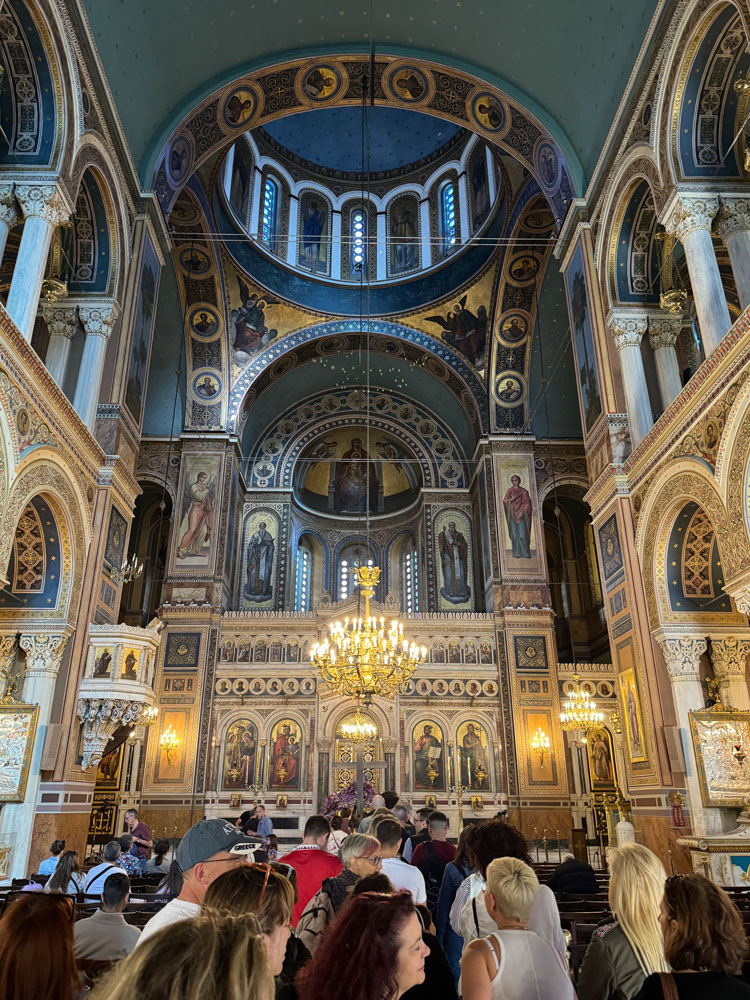
Today is Good Friday and there are celebrations in the city. One event is a parade in the evening with people carrying candles, and a bier, decorated with flowers is also carried. At the front of the church was the bier that will be carried in a parade this evening. It represents the way the body of Christ was carried after his crucifixion.

After we left the church, we went to Cardinale, an Italian restaurant close by, for dinner.
The Good Friday parade is scheduled to come to the Parliament Building about 9:30 this evening. The street was packed with spectators, so I went up to our room and took pictures from the balcony. I was a bit late getting to our room so I missed the arrival of the parade. Here's what it looked like when I started shooting (wide shot).
I'm using my iPhone 15 for telephoto shots and it doesn't do well with those, so please pardon the quality.

The bier was brought to the stand, and a Greek Orthodox priest gave a blessing over the speakers.
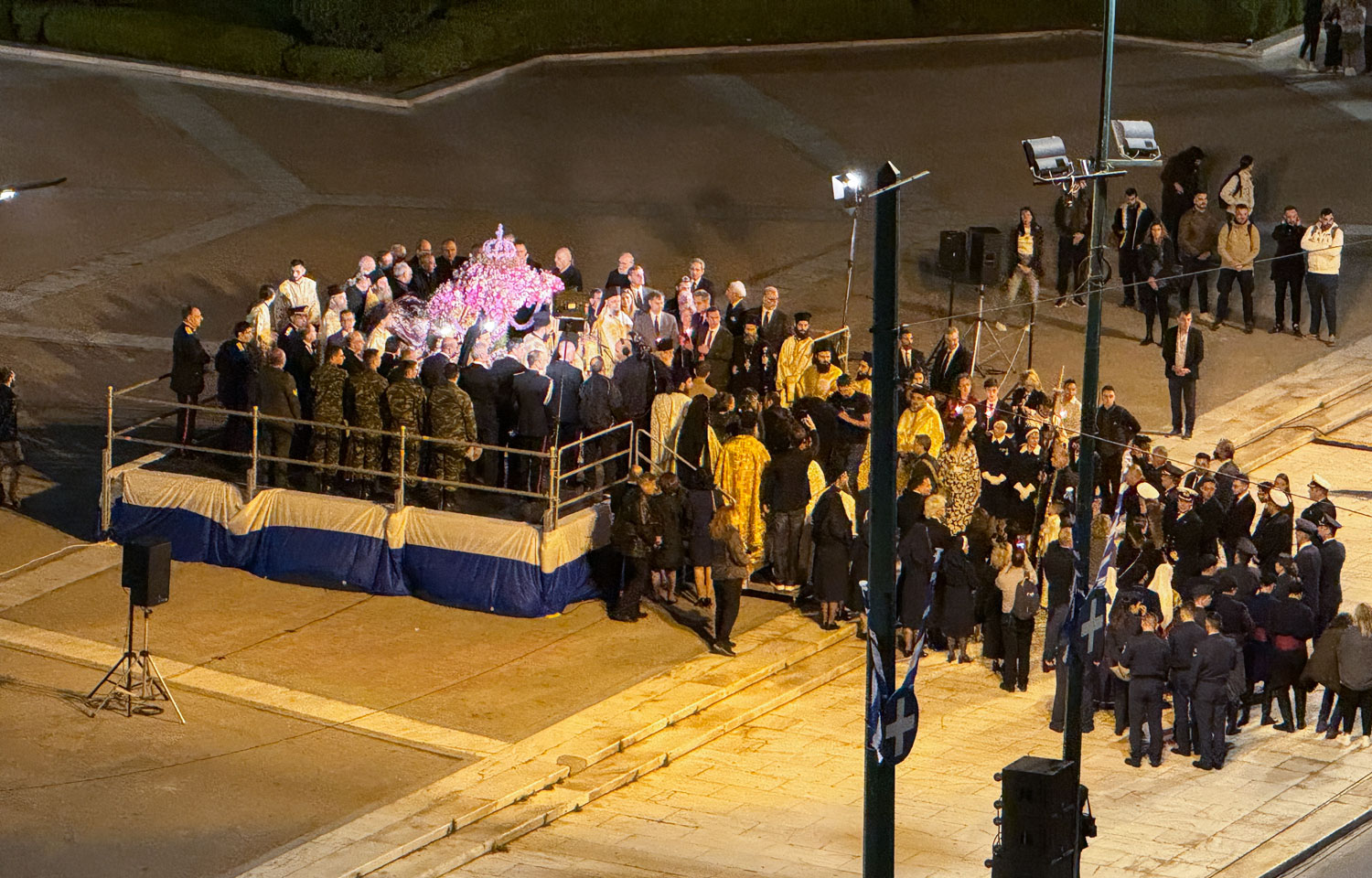
After the event ended, we headed to bed. Tomorrow, we meet the ship.
I'm going to end this page here, it's getting rather long.